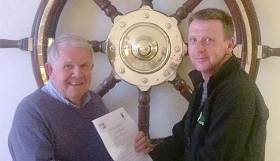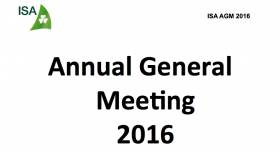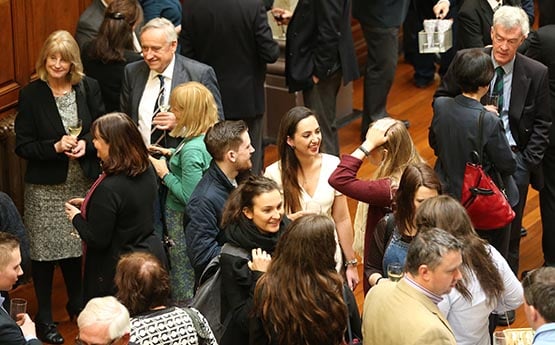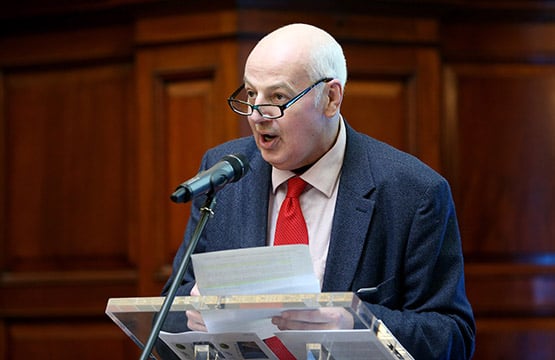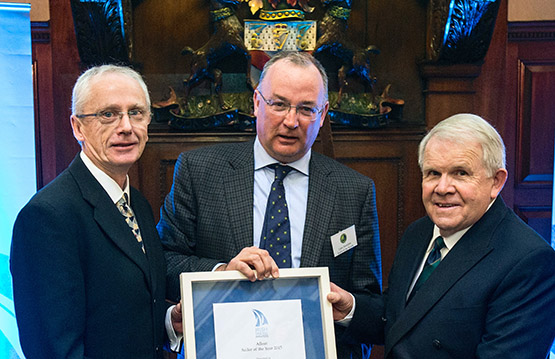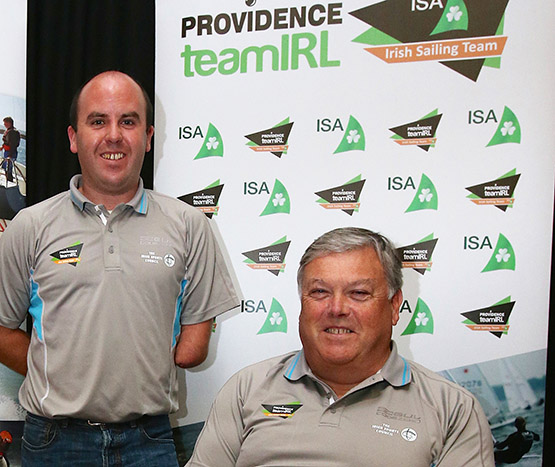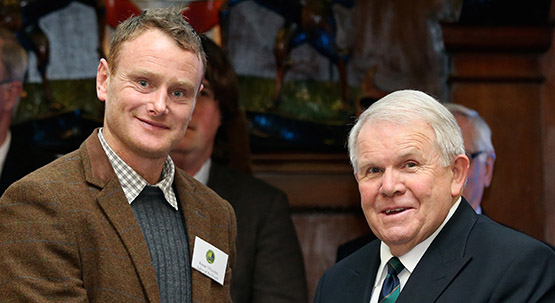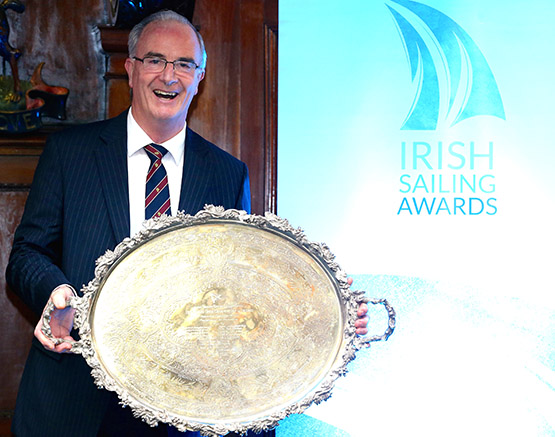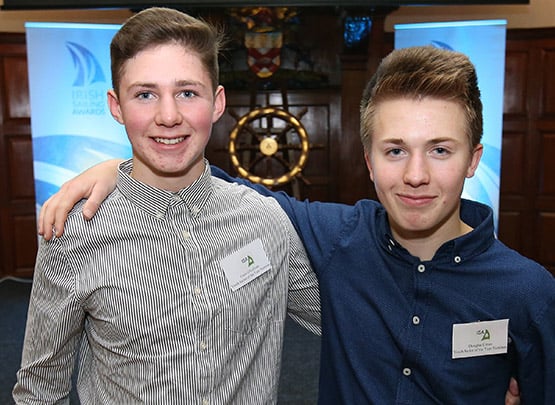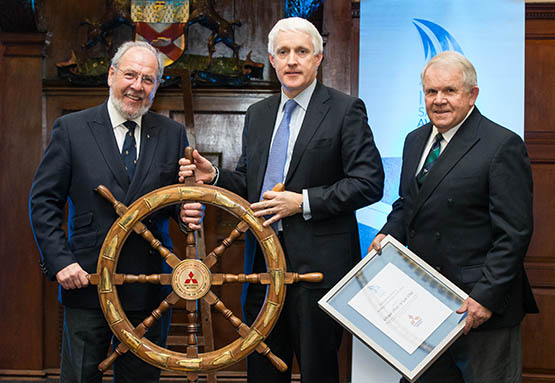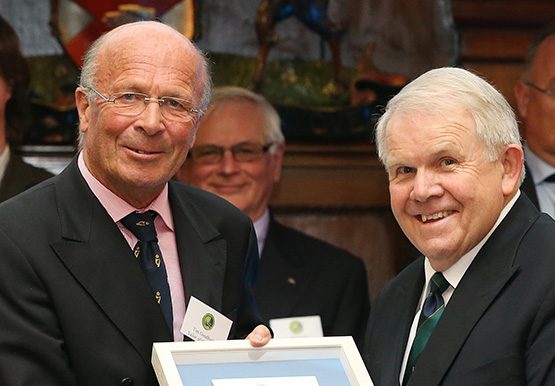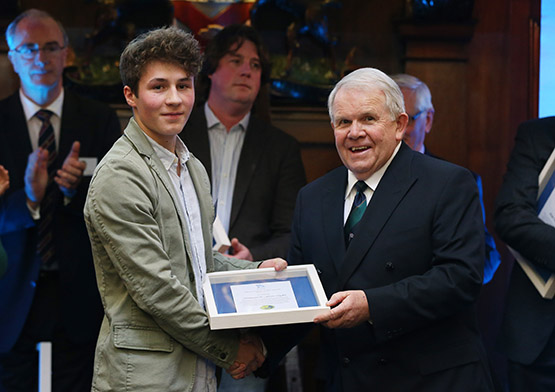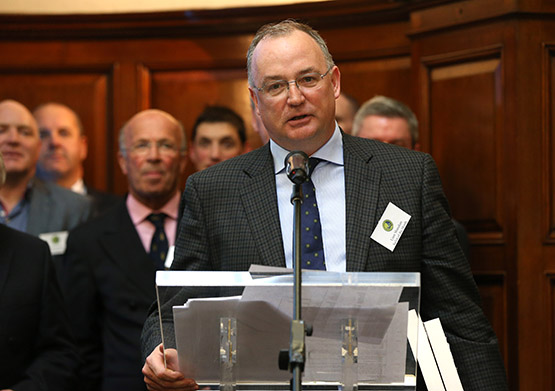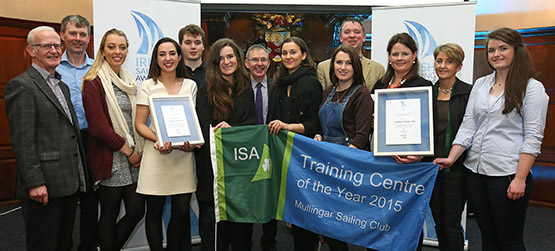Displaying items by tag: David Lovegrove
September is always a bit of a gamble as the time for staging a major sailing championship, for although the sea temperature may be at its warmest, the closing in of the evenings and a sometimes unexpected nip in the air can combine with big winds – usually from the west – to tell us that our predecessors in sailing may have been wise in drawing most sport afloat towards a close by the end of August.
Yet, with modern boats and the growing precision of weather forecast, early September can be a real Godsend in completing the season’s main national and international events. But when David Lovegrove arrived at the beginning of September to oversee the Royal Irish YC’s staging of the SB20 Worlds 2022, he may have seen it as just another day’s voluntary work at the top level of the sport, as he had already master-minded the Wave Regatta at Howth in early June, and he’d overseen a host of other lesser events throughout the summer before taking on the J/24 Euros at his home port in the week before the SB20 Worlds began across the bay.
It was a tough one. If September was coming in as a month of gentle mists and mellow fruitfulness, it was doing so somewhere other than Dublin Bay. This was the Big Boys’ Game, and no mistake. But they battered their way through, and by the end Jose Paulo Ramada of Portugal was the winner out of a 56-strong fleet, while best of the Irish were Royal St George’s Michael O’Connor, Davy Taylor and Edward Cook in fourth.
Afterwards, David Lovegrove supposedly retired home to rest for a while at his house on the Hill of Howth. But rumours abound about him being spotted in the main role aboard the Committee Boat at various events since the SB 20s were blasting so spectacularly around Dublin Bay. Either way, he certainly deserves praise for his extensive work on behalf of sailing.
David Lovegrove, President of the Irish Sailing Association, steps down in a week’s time. The conclusion of his three year period in office at the up-coming ISA Annual General Meeting relieves him of what is surely the most demanding voluntary position that Irish sailing can offer. W M Nixon has been finding out more about a busy life with a remarkable record of freely-given service to our sport.
Of all Ireland’s many sports, it is sailing and boating in its numerous forms which has most suffered attrition during the economic collapse after the crazy Celtic Tiger years. Despite efforts to make boat-oriented waterborne activities as affordable as possible through shared ownerships and other club and group schemes, there’s no escaping the fact that it is quintessentially a vehicle activity. It still depends to a large extent on the continuing personal enthusiasm of private boat owners. And expenses inevitably rise exponentially as boat sizes increase.
Yet as the downturn arrived with unprecedented suddenness in 2008-09, sailing and boating groups found themselves with fleets they could no longer afford. They’d clubhouses – many of them listed historical buildings - that seemed increasing like unnecessary luxuries. Recovery was slow, if it occurred at all. In some cases it ddn’t, and the national authority, the Irish Sailing Association, was heading into financial meltdown by 2012-2013.
During the boom years, its expansion had reflected the euphoric national mood. An increasing permanent staff with a rocketing salaries and wages bill led to an unwieldy management structure which was inevitably slow to respond to the new and rapidly-changing circumstances. It was clear that some dramatic gesture was needed to show that there was going to be a complete change of the attitude and ethos of the Association’s governance.
 David Lovegrove (second right) in the family garden in his own-built Fireball Simba at the age of 18, with crewman Joe McKeever on the right. His father gave him £100 to build the boat, but with careful project management, he was able to return £3 to his dad when the job was finished
David Lovegrove (second right) in the family garden in his own-built Fireball Simba at the age of 18, with crewman Joe McKeever on the right. His father gave him £100 to build the boat, but with careful project management, he was able to return £3 to his dad when the job was finished
Under the constitution of the ISA, a new President was due for election at the AGM in the spring of 2014. Normally the new incumbent would be drawn from the ranks of the existing Board members. But there was a reluctance by anyone to allow their name to go forward for what would in effect be a full-time damage-limitation job carried out on a voluntary basis.
And in any case, there was an increasing feeling that things were in such a mess that the only way to show that they were serious about real change was to persuade a respected outsider to take on this thankless task, a poisoned chalice.
In a larger sailing country, the President of the National Authority is a position of dignity and considerable importance. But in terms of our own sailing history, the ISA is of only relatively recent formation. In Ireland, with our almost incomparably long sailing history, we’re in a country where it is thought natural that the senior club should be headed by an Admiral who is treated as an equal - at the very least - by the Admiral of the Naval Service itself.
However, the President of the ISA has not been automatically accorded the dignity his position should merit, unless he or she is a person of such standing in the sailing community nationally that their natural air of authority propels them into a position of equal respect. And in times past, in dealing with the senior flag officers of the major clubs, the ISA President could sometimes feel like a relatively weak mediaeval king dealing with a group of powerful warlords, each with a treasure chest which often out-matched the monarch’s central funds.
But for the ISA, the saviour has become international competition towards Olympic level, which is basically the only form of sailing that the Irish public and Irish government departments understand. The ISA controls this, and thus it is the conduit of a source of public funding which gives it a level of independence from the wayward clubs.
Yet in the final analysis, the ISA goes back to being reliant on the clubs, for it is only through clubs that the Association is able to ensure a ready supply of talented sailors, the best of whom will enable them to tap into the honeypot of central funding for performance athletes.
So there we were in 2013 with most of the clubs severely stretched, and the ISA living way beyond its means, yet in order to get things back on an even keel and bring sailing back to life, a completely fresh President had to agree to take on this hugely demanding job.
It’s not the first time that David Lovegrove of Howth has found himself being unexpectedly propelled into a position of national and international sailing significance from what was almost an outsider position. Back in the 1960s, he was one of the pioneers – led by the great Roy Dickson of Sutton Dinghy Club – who got the Fireball class going to national success. By 1966, Lovegrove had won through to be the Fireballs’ representative in the Helmsmans Championship, raced that Autumn in Enterprises in Kinsale.
The defending champion was James Nixon of Trinity College (DUSC), and though neither of them was to win in Kinsale, Nixon liked the Lovegrove approach to racing, and got to talking with him. He was amazed to find that although Lovegrove was also a Trinity student, he had not thought to get involved with the college’s successful team racing club, as his sailing attention was absorbed with the successful Fireball Simba, which he’d built himself.
“But it’s your DUTY to try and get a place on the Trinity team!” expostulated Nixon. As James Nixon is my brother, I can well imagine the scene.
The upshot of it was that this talented outsider was brought into the heart of the Trinity team-racing fold, and became one of that lineup of college superstars who, in the late 1960s, had won just about every trophy going, in one particular year holding the Irish title, the Northern Universities title, and the British title all at once.
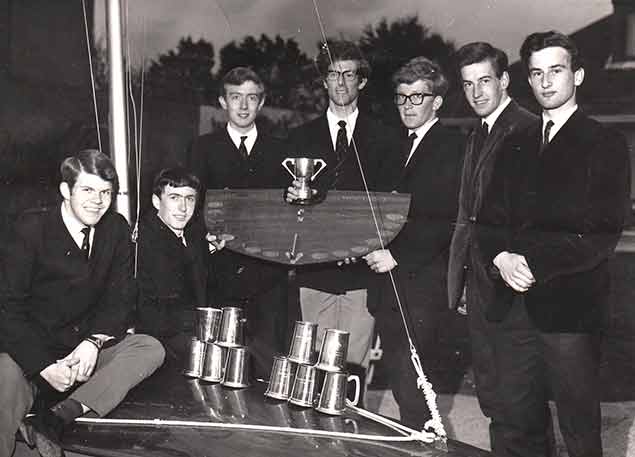 The Trinity heroes. The all-conquering Dublin University SC team of the late 1960s were (left to right) David Lovegrove, Johnny Ross Murphy, Vincent Wallace, Owen Delany, John Nixon, Peter Craig, and Peter Courtney
The Trinity heroes. The all-conquering Dublin University SC team of the late 1960s were (left to right) David Lovegrove, Johnny Ross Murphy, Vincent Wallace, Owen Delany, John Nixon, Peter Craig, and Peter Courtney
From that time there emerged David Lovegrove’s reputation amongst a much wider grouping than Sutton sailing and the Fireball class. He was perceived as an almost diffident steady Eddy type, capable of complete dedication and total enthusiasm when it was most needed. In the Autumn of 2013, Irish sailing administration needed it very badly indeed. Although initially Lovegrove rejected out-of-hand the idea of being parachuted abruptly into the ISA Presidency, a friend from those very special years of the late 1960s, Brian Craig - the quintessential backroom operator of Irish sailing - eventually persuaded him that he was the only man for the job, and he took it on in the Spring of 2014.
So who is he, this man who stepped into this hottest of hot seats when it was a very cold place, and all within a very short period of retiring from a demanding international career, while his own personal involvement in sailing was increasingly committed to high level Race Officer activity?
 It was on Nairobi Dam in the 1950s that David Lovegrove started sailing, with International Cadets, Fireflies, and International 505s. His father was probably in charge of the track on which the old steam train is running on the far shore of the lake
It was on Nairobi Dam in the 1950s that David Lovegrove started sailing, with International Cadets, Fireflies, and International 505s. His father was probably in charge of the track on which the old steam train is running on the far shore of the lake
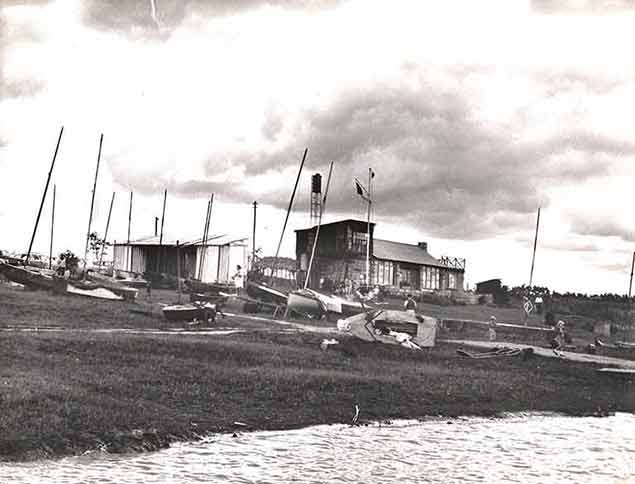 Sailing nursery. The Aqua Club on Nairobi Dam – David Lovegrove’s first sailing was with the International Cadet in the foreground, on its side for work on the mast
Sailing nursery. The Aqua Club on Nairobi Dam – David Lovegrove’s first sailing was with the International Cadet in the foreground, on its side for work on the mast
Although born in 1947 to a family living on the Sutton waterfront facing southwest into Dublin Bay, his father – a railway engineer – wasn’t into sailing, and in the early 1950s the stagnating Irish economy persuaded him to move his family to Kenya. It was there, at the age of eight or nine, that a school friend from a sailing family introduced him to the wonders of it all on nearby Nairobi Dam. He was completely hooked - “smitten” is the word he still uses today. In short order, his newfound enthusiasm took him through International Cadets, Fireflies, and on into the exalted heights of the International 505 class. But while the sailing on the lake was idyllic, the political position in Kenya was rapidly deteriorating. In 1963 the Lovegrove family returned to Ireland and the house in Sutton, and his mother, concerned at her sixteen year old son’s need to adjust to the Irish climate, bought him a classic duffle coat which he keeps for good luck to this day, though it’s now well-covered with glue and paint from his boat-building habit.
Ten years earlier, he’d been unaware of Sutton Dinghy Club, but now he went along to see what was happening, and met up with Ian Sargent who, even then, was promoting the IDRA 14 class with total single-mindedness. The class in Sutton had a boat with a girl owner, Eleanor Hazleton, who didn’t like steering. For three years through Sargent machinations, David Lovegrove helmed her boat while she crewed, and the boy just back from Kenya got drawn ever deeper into Irish sailing.
 Simple spot. Sutton Dinghy Club as it was when David Lovegrove - recently returned to Ireland from Kenya - joined it in 1963.
Simple spot. Sutton Dinghy Club as it was when David Lovegrove - recently returned to Ireland from Kenya - joined it in 1963.
The development pace was being set in Sutton by the ever-enthusiastic, always-obliging Roy Dickson whose workshop was available to anyone with boat plans, and in 1965 David Lovegrove’s father provided his son (aged 18) with £100 to build a Fireball. Always one to keep meticulous records, young Lovegrove built his new Simba as economically as possible, and when the boat was ready to sail, he totalled his final figures and was able to return £3 to his dad.
Crewed by the likes of Joe McKeever, Nat Healy, and then Vincent Wallace who was to be a team-mate in the stellar Dublin University all-conquering squad, young Lovegrove found himself competing in the Fireballs in a decidedly eclectic group of all ages, abilities and backgrounds. It gave him an unrivalled overview of the Irish sailing scene at its most diverse, and provided close friendships which have lasted to this day.
Meanwhile in life ashore he graduated from Trinity, married Kate Chillingworth who more than tolerated his sailing and boat-modifying enthusiasms, and started a family. They now have two daughters, Sarah and Joanne, both of them sailors. And David himself began a distinguished career with the Industrial Development Authority, helping to build a new Ireland which was remote indeed from the stagnating place he and his parents had left in the early 1950s.
While busy with his work at home and abroad, he continued sailing as much as possible, and in the late 1970s his focus shifted across the peninsula to Howth as he reckoned the rapidly-growing Squib class there provided the ideal boat for family use while also meeting the needs of the man of the house, who was mad keen on racing. Howth was in its rapid development stage, with the new marina opening in 1982, and the Lovegroves moved up in boat size in 1983 to the newly-introduced Puppeteer 22, a boat-with-a-lid, albeit a small one. As with their Squib, the boat’s name was Snowgoose, and many a trophy she added to the list.
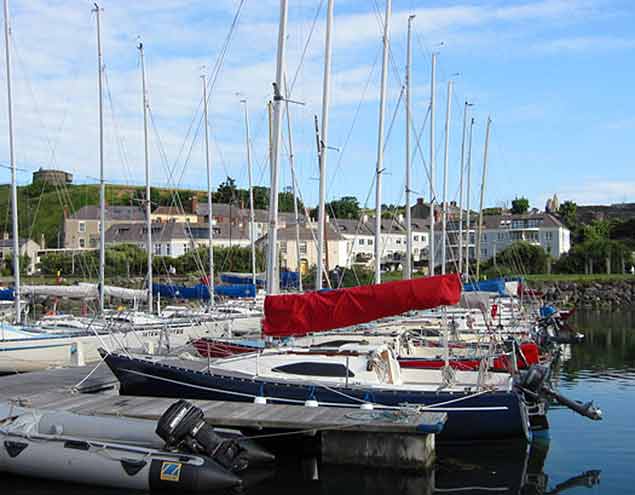 The Puppeteer Class at Howth. One of the most successful local classes in the harbour, the Lovegrove family have owned one of them since the class’s inauguration in 1983. Photo: W M Nixon
The Puppeteer Class at Howth. One of the most successful local classes in the harbour, the Lovegrove family have owned one of them since the class’s inauguration in 1983. Photo: W M Nixon
Howth Yacht Club in its period of greatest expansion needed calm, capable administrators and negotiators, and David Lovegrove soon found himself drawn into various committees and sub-committees. But in addition to continuing as a keen sailor, he was further developing another of his interests afloat – as a Race Officer, where he acquired international status. He was involved in running the famous Admirals Cup trials of 1987 at Howth, where the Chairman of the Selectors, Clayton Love, insisted that racing continue despite the 50 knots-plus of wind. The race team of Jock Smith and David Lovegrove obliged, even if it did mean that at one stage the Dubois 40 Jameson was all over the place waving her legs in the air, while the committee boat rounded out their day by rescuing a capsized mark boat, a Dory, which had headed skywards over a steep breaking wave, and just kept on going until she’d looped the loop.
 The Dubois 40 Jameson struggling with 50-knot gusts at the Admirals Cup trials at Howth in 1987. Photo: Rick Tomlinson
The Dubois 40 Jameson struggling with 50-knot gusts at the Admirals Cup trials at Howth in 1987. Photo: Rick Tomlinson
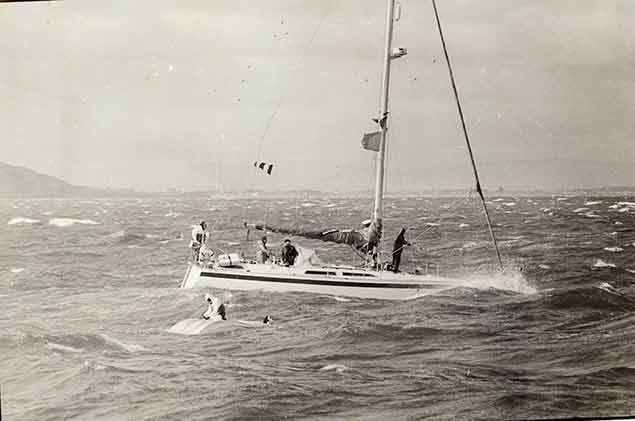 The winds were so strong at the 1987 AC trials that a Dory heading into the waves looped the loop. David Lovegrove is at the helm of the Committee Boat now doing rescue duty. On the upturned boat is Brian Jennings, for whom David Lovegrove had built a Mirror Dinghy with which young Jennings won the Irish Mirror Nationals
The winds were so strong at the 1987 AC trials that a Dory heading into the waves looped the loop. David Lovegrove is at the helm of the Committee Boat now doing rescue duty. On the upturned boat is Brian Jennings, for whom David Lovegrove had built a Mirror Dinghy with which young Jennings won the Irish Mirror Nationals
With the new marina-side clubhouse completed in March 1987, Howth’s sailing potential had moved up several gears, and inevitably David Lovegrove’s talents were recruited towards the flag officer stream, with the powers-that-be positioning him so neatly that he was right on the starting grid to become Commodore as Howth YC’s Centenary came up over the horizon in 1995. Thus it was he and Kate who welcomed President Robinson to the Club for the Centenary Fleet Review, the highlight of a busy season in which Howth boats were achieving notable success at home and abroad.
 It’s the Howth Yacht Club Centenary in 1995, and HYC Commodore David Lovegrove and his wife Kate welcome President Mary Robinson to the club. Photo courtesy HYC
It’s the Howth Yacht Club Centenary in 1995, and HYC Commodore David Lovegrove and his wife Kate welcome President Mary Robinson to the club. Photo courtesy HYC
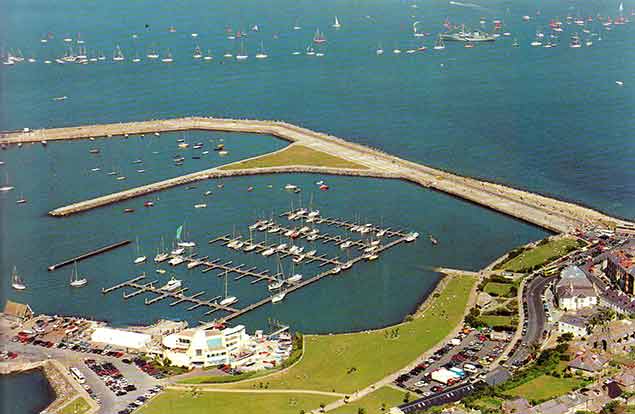 Fleet review. With President Robinson reviewing the Howth YC Centenary Fleet from the Guardship, the marina is almost empty. Photo courtesy HYC
Fleet review. With President Robinson reviewing the Howth YC Centenary Fleet from the Guardship, the marina is almost empty. Photo courtesy HYC
While he continued as an avid race with the Puppeteer 22s – he’s a One-Design man through-and-through – he was ever ready to take on some boatwork task, and back in the day he’d built each of his daughters optimised Mirror dinghies. In fact, his workmanship was so impressive that the local GP, Damien Jennings, had asked him to build another Mirror for his son Brian, offering wads of cash. Yet all David wanted was the cost of the materials to be covered, as he found the task sufficiently rewarding in itself. But inevitably it ended up being done in the winter, and one night it was gone 9.0pm when he finally got stuck into the next task in the garage-cum-boatbuilding-shed, installing the boat’s tanks with the garage doors and windows sealed off, and the heaters going full blast.
Anyone who ever built a Mirror will recall that while most of it could be done alone, at certain stages a second pair of hands is essential, however briefly, and on that night this stage occurred at 1.30 am. There was nothing for it but to waken Kate who had been long asleep, and beg for her help. She hauled on her dressing gown, threw an old rug on the garage floor, and slithered in under the boat to provide that vital bit of back-up at the key moment, while glue dripped on her forehead.
The job done, her husband relaxed, and started smothering her with thanks in profusion. “What on earth were you thinking” he asked, “lying there on the cold floor of the garage with the glue dripping on your face?”.
“I was thinking” she said, “of Damien and Bernadine Jennings snug at home and well asleep in their warm bed”. But the boat was a winner – young Brian Jennings went on to win the Irish championship with her.
David Lovegrove took early retirement from the IDA at the age of 55, but that was only to enable him to set up an international consultancy which took him all over the world for the next dozen years, advising governments in countries as diverse as Chile, Uruguay, Brazil, Colomibia, Peru, Surinam, every country Central America and many other places in the Middle East down to Sudan.
At home between these extensive travels, he became ever more immersed in the world of race management, and over the years built up a team around him, a team now functioning so smoothly like a well-oiled machine that they can simply transfer the entire squad to whatever location needs race management services. But given the choice, they prefer to operate from Howth’s own larger Committee Boat Star Point, which has been cleverly modified to David Lovegrove and his team’s suggestions, coupled with the suggestions of other top Howth race officers like Derek Bothwell, to provide a formidable race management platform.
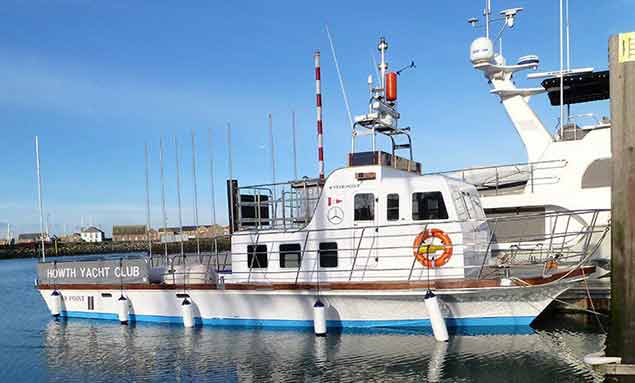 Star Point, the larger of HYC’s two Committee Boats, may not be the most handsome vessel afloat, but with clever modifications suggested by David Lovegrove and other experienced race officers, she is one of the most effective committee boats in the country.
Star Point, the larger of HYC’s two Committee Boats, may not be the most handsome vessel afloat, but with clever modifications suggested by David Lovegrove and other experienced race officers, she is one of the most effective committee boats in the country.
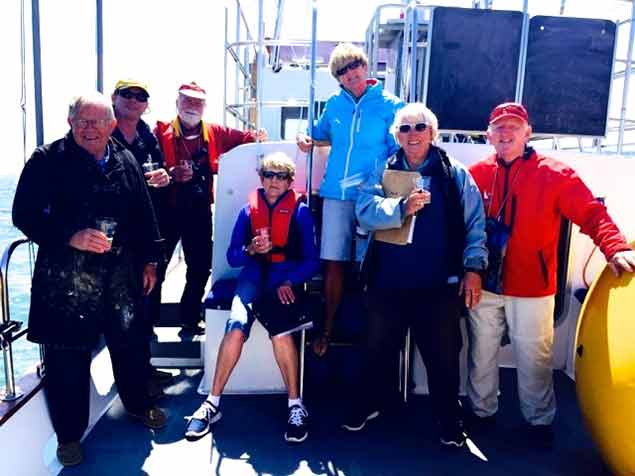 The Lovegrove Race Team on Star Point at last year’s ICRA Nationals at Howth are (left to right) David Lovegrove with his notorious 1963 duffle coast, Algy Pearson, Rupert Jeffares, Suzanne Cruise, Judith Malcolm, Kate Lovegrove, and Harry Gallagher
The Lovegrove Race Team on Star Point at last year’s ICRA Nationals at Howth are (left to right) David Lovegrove with his notorious 1963 duffle coast, Algy Pearson, Rupert Jeffares, Suzanne Cruise, Judith Malcolm, Kate Lovegrove, and Harry Gallagher
As to the day job with its extensive travelling, he’d made a deal with himself that when the homeward journey became more exciting than the outward journey, then he’d jack it in, and that stage started to arrive four years ago. But he’d barely settled in to his new more relaxed situation when the ISA came calling, and for the past three years life has been very hectic indeed.
The ISA has had to be slimmed down, shedding projects like the J/80 Sailfleet flotilla, and he went strongly with the idea that a Strategic Review should be undertaken, run by key people like Brian Craig and former President Neil Murphy.
That review came down firmly in favour of re-emphasising the role of clubs in the ISA support structure. Though it didn’t meet with total approval throughout the sailing community, particularly among those who run commercial sailing schools, at least a marker could be put down, and work could begin on improving relations with every area of sailing, for things had come to such a sorry pass that various specialist groupings were at each other’s throats, and also frequently into loudly attacking the ISA when they felt so inclined.
With his patient ready-to-listen attitude, and his willingness to travel in pursuit of opinions, David Lovegrove was the right man for the long slow progress of peace-making and creative negotiation, which will continue. He insisted that the Board meet monthly, and that it move its meeting place around the country in order to give every area a sense of direct involvement and promote Try Sailing projects.
All this was time consuming and decidedly unspectacular, but it was very necessary, and even as this sometimes dull but essential work continued, things were happening to give Irish sailing a fair wind. In 2014, Ireland re-took the Commodore’s Cup under the inspired captaincy of Anthony O’Leary, and as he was at the time also the ISA All-Ireland Champion, the stardust rubbed off on everyone.
Despite the lingering effects of the setbacks of the recession, people were getting out and winning major events in boats which were no longer in the first flush of youth, but were all the better sailed for that, and almost invariably it would be noticed that the President of the ISA, in addition to his many duties, was as usual working aboard a Committee Boat making sure that races were run with punctilious precision.
Gradually a greater level of civility returned, and the mod was good as 2016 came upon us to provide the greatest Irish sailing season ever, starting with a bronze medal in the Youth Worlds for Dougie Elmes and Colin O’Sullivan, going on with success for everyday Irish sailors at home and abroad, then too we’d a fabulous Volvo Round Ireland Race from Wicklow, there was a brilliant innovation with the Beaufort Cup series in Cork, an international dinghy regatta to top all others with the Laser Radial Worlds in Dublin Bay when our own Ewan MacMahon won Silver, and then an excellent all round showing in the Rio Olympics topped by Annalise Murphy winning the Silver Medal.
No-one deserved this overall success more than the patient and dutiful David Lovegrove. Typically, though, he wasn’t there on the beach in Rio when Annalise Murphy brought Ireland and the world to a halt with her cliff-hanger win of the Silver Medal. On the contrary, he was in Plymouth in southwest England, fulfilling a longterm commitment to be Race Officer at the J/24 Europeans.
That’s the way it is with David Lovegrove. Duty will always come before celebration. But apart from steadying the ship at a time when the ISA and the Irish sailing community were going through a very rough time, he has brought an extra dignity to the role of ISA President. He may be small in stature, but David Lovegrove is a big man in his approach to the problems of life. He quietly withstood some seriously vindictive yet totally undeserved personal attacks when he first took over the post of President. For a while, things were very unpleasant. But he has stood his ground and has listened with courtesy to all points of view.
Thanks to his approach, the position of President of the ISA is now beginning to receive the respect it deserves as a special position, regardless of the personal situations which may arise from time to time. For that alone, Irish sailing should be very grateful to David Lovegrove. But we’ll continue to be grateful to him for many years yet, for as soon as the new season swings into action, he’ll be there on the starting line with a season’s programme of race organisation which would be beyond many men half his age.
Throghout all this, his wife Kate has been the rock on whch has been able to rely. Late in the Spring of last year, she realised it was all in danger of becoming overwhelming, so she whisked him away for five weeks clear of everything to do with Irish and international sailing. She did this with the trip of a lifetime to China on the Trans-Siberian Express, which does indeed get across Siberia, but “express” is stretching it bit. However, the President returned to Ireland completely refreshed to see out one marvellous sailing season which he very richly deserved.
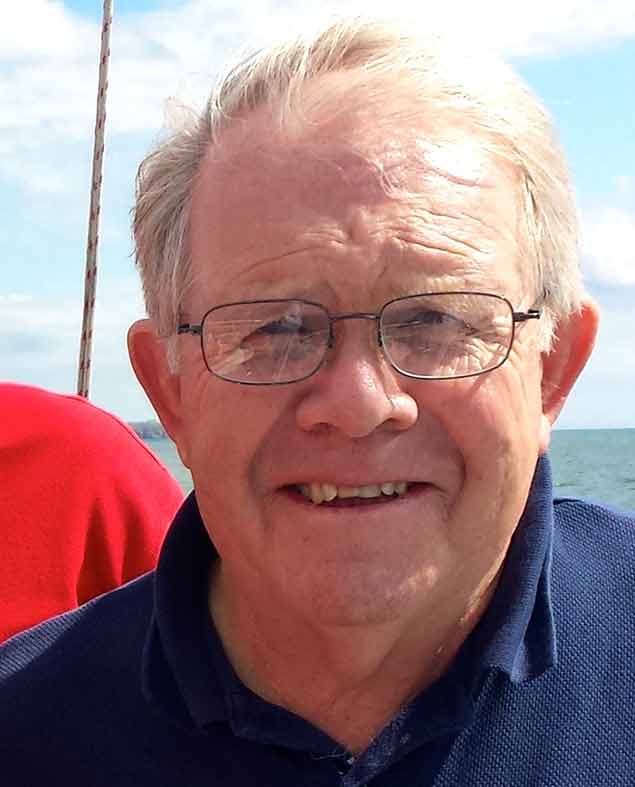 With his three year ISA Presidency completed in a week’s time, David Lovergore is looking forward to a busy season as a Race Officer at home and overseas – and he might even get to do some racing himself on his Puppeteer 22 Snowgoose. Photo: Judith Malcolm
With his three year ISA Presidency completed in a week’s time, David Lovergore is looking forward to a busy season as a Race Officer at home and overseas – and he might even get to do some racing himself on his Puppeteer 22 Snowgoose. Photo: Judith Malcolm
The Irish Cruiser Racing Association (ICRA) and the Irish Sailing Association (ISA) have signed a Memorandum of Understanding (MOU) for the two associations to work closely together to support cruiser racing efforts. Initiatives such as ICRA's crew training 'Crewpoint' resource will be developed further to help give crew and boats an easier path to matching up opportunities to race together.
Crewpoint will help to unite crew with skipper and boat, as well as create a greater awareness of access to sailing. For non boat owners ICRA, Crewpoint and the ISA are linking up with the Try Sailing campaign to create access points for more people to give sailing a try and to encourage more sailors to give racing a try in open days, crewing opportunities and events.
To help support the development of Cruiser Racing in Ireland all ECHO and IRC handicap fees are reinvested in the development of Cruiser Racing.
President's Report of the Irish Sailing Association AGM
Ladies and gentlemen welcome to the AGM of the Irish Sailing Association, now in its 70th year since its foundation in 1946, as the Irish Dinghy Racing Association. In 1946, when the sole requirement was to promote dinghy racing, little did our founding fathers realise what their brainchild would grow into. Today, it is the shear diversity of watersports in Ireland that is difficult to comprehend. Hardly a year goes by without some further extreme form of sailing being conceived and attracting its following. It is sometimes difficult for the Association to keep track of developments let alone find ways of representing them!
A quick look across the diversity of our sport gives some idea:
- Dinghy racing, covering the range from optimists to 49ers
- Keel boat racing from Squibs and Glens to top of the range Commodore Cuppers
- Cruising sailors, who by their very nature are lone sailors
- Surfboarders and Kiteboarders
- Power boating
- Add into that the administration of racing and handicaps, international representation, regulation and inspections, lobbying and complying with ever changing and evolving legislation, gives you some idea of the workload of the ISA.
Over the past two years, one thing that has struck me is the fact that each of these groupings is independent of the others and is really oblivious as to what the ISA is doing for the sport generally and for other groupings. This proves difficult, because into the mix you also have to add in the wide range of classes, clubs and training centres. So, if we have not implemented all the changes that your class, or club or training centre hopes for, please bear with us, we will get to you.
Having said that, we are making progress and 2015 has been another year of change and achievement. It must also be remembered that we are only in year one of a five year implementation plan as set out in the Strategic Plan, which was approved by last year’s AGM.
I, and indeed Irish sailing, is most fortunate in having a Board of dedicated Directors, who give tirelessly of their time:
Brian Craig: Training and Coaching
David O’Brien: Secretary
Paddy McGlade: Cruising and Risk and Governance
Sarah Byrne: Dinghy racing classes
Colm Barrington: Olympic Steering Group and High Performance
Robert Dix: Representation
Pierce Purcell: Access and Participation
Jack Roy: Racing
I would also like to thank Roger Bannon, our Treasurer for the past twenty months, who, due to pressure of work had to stand down a short while ago.
A quick review of the major achievements of the past year shows the following:
Dinghy Racing Classes:
One of the main objectives here has been to improve communications with the dinghy classes. However, there is still a lot more to be done in this area.
The Club Racing Classes survey, in addition to the communications issue, highlighted the large segmentation of dinghy classes, which, given the smallness of the Irish market, is a major issue
The Regional Development Officers have worked closely with clubs and classes to identify local Club ‘pathways’ that will build on local/regional penetration to improve competition.
The introduction of Dinghy Fest by Royal Cork Yacht Club was a very positive event and it is hoped that events of this nature will help promote dinghy sailing. The initiative has been taken up by Galway, who will run Dinghy West in 2016 and dates for Dinghy Fest 2017 are already under discussion. I would urge sailors to support this event and other such events where classes combine to run regional and national championships.
Looking to this year, there is a very extensive schedule of work planned:
- Consult with classes to examine fall out at youth level.
- Facilitate Event Calendar discussions with classes starting late August, November is too late.
- Renewed emphasis on promotion of double-handed dinghy sailing
- Carry out a junior and youth survey, with a target date of late April/early May. This will further inform on how the ISA as well as club and classes can formulate policy and initiatives to transition and retain more sailors into adulthood. It should be noted that while we have heard from parents and classes, we still have to hear from the youth themselves, this will be important as they are the lifeblood of our sport.
- The Racing Policy Competition Policy Group, as defined by the 2016 focus group, will be reformed to some extent to reflect representation from those who will deliver on the ongoing needs of the group as defined by the focus group and objectives reflected in the Strategic Plan.
- Promotion of third Level Sailing & Racing:
• Liaise with College Sports Administrations, we will look to provide support for organising events, event management, what is required, to run College Club and Intervarsity circuit successfully.
• Raise profile in the media, while this is up to college sailors themselves, we plan to give them guidance on how to proceed.
• Promote student transition and involvement in keelboat racing. Howth Yacht Club has been successful here with their K25 group. This concept to be explored and expanded where possible. Work with local clubs to identify opportunities to expand into keelboats on a more regular basis and build on the success in CIT and UCC last year with the 1720 event
• Club Pathway definition by Regional Development Officers to assist transition to ‘adult’ classes & encourage race formats for distinct groups of junior/learner racing to ensure:
i. Accessibility and sustainable participation at Club and local level.
ii. ICRA Crew Point initiative will assist in putting more keelboats on the water over time.
Two important issues which were raised in the Satisfaction survey with Classes are:
• Event management templates and documents to be developed for the ISA elibrary, which will be accessed through the website. These will be aimed at assisting classes, clubs and colleges to develop standard documents to maintain continuity when administration changes and give:
o Class specific event guidance to host Club and Race Officer
o Event management guidance documents and checklist
o Post event evaluation for clubs and debrief checklist for clubs and classes
o Classes coaching and clinic template guidelines
• Many clubs identified a gap between Try Sailing, formal courses and transition to racing for youth and adults alike across dinghies and keelboats. The policy group will work with Training Policy Group to build a simple, structured achievable learning program, with delivery by clubs, class sailors, instructors or coaches
Cruising Policy Group:
In promoting cruising, we have been very careful not to transgress into the domains of the Irish Cruising Club (ICC) and the Cruising Association of Ireland (CAI), both of whom represent cruising sailors. However, as there is a large group of cruising sailors who are members of the ISA, we felt that we had to actively support their activities.
The newly formed policy group decided to continue to develop some of the suggestions from 2014. The main one being, holding a Cruising Conference. The event went extremely well with good quality speakers, good range of topics and an oversubscribed attendance.
Naturally we have learnt from the event in terms of length of time speakers were given, need for fewer speakers, bigger venue etc. In the future, it is likely that there will be a half day conference in the odd years in the regions (Cork area 2017, Galway area 2019, for example) with a one day conference in the Dublin area on the even years. This ties in with RYANI on the odd years.
We joined the CoolRoute project to keep informed of their progress and to contribute where possible.
The group drafted and published Guidelines for running a Cruise in Company (1 day, weekend and weeklong cruises). They have also updated and added to the Cruise Routes around Ireland and plan to enhance these with better chartlets.
We continue to assist CAI and there have been discussions with their Commodore on activities they might consider to create more opportunities for CAI members to meet and interact.
Risk Management and Governance:
The Board re-drafted the Code of Conduct for ISA Directors from a Sport Ireland template.
We also have a new Risk Policy Procedure (with help from RYANI), and a new Risk Register.
During the year, in collaboration with Sport Ireland, the Board undertook a review of its workings and communications. This led to a detailed report being prepared by the Institute of Public Administration. This led to a document on the Roles and Responsibilities for ISA Directors and this is currently being studied by the Board to see how it can inform the work plans for 2016 and beyond.
Training – A Year of Transition:
2015 was a year of transition for ISA Training as the significant decline in activity and the reduced satisfaction, as recorded in the Strategic Review, in ‘the ISA training product’ necessitated the reorganisation of ISA Training in late 2014.
The Staff, Instructor Trainers and Training Policy Group had a busy 2015 bedding in the new structures put in place to improve the support to member clubs and centres; introducing changes to make Instructor qualifications more attractive and standards more consistent; while also planning some of the more fundamental changes for 2016.
Small Boat Sailing Scheme:
A number of changes were made following feedback on the Small Boat Sailing Scheme (SBSS):
The changes initiated for 2015 were:
• Instructor revalidation period extended from 3 to 5 years.
• Instructor Revalidation Courses reduced from a two-day into a one-day ‘practical skills’ course organised directly with training centres.
• VHF Licence no longer a mandatory prerequisite for dinghy instructor
• Outsourced the provision of Emergency Care course element at reduced cost to aspiring instructors
• Pre entry Course - theory elements put online by way of sample background papers.
• Instructor Pre entry and Revalidation Courses - developed an Explanatory Guide with the Instructor Trainers to ensure each element of the assessments are marked consistently across the Instructor Trainer panel.
Instructors:
The availability of qualified Instructors to clubs and centres remains a key area of attention. While progress was made in 2015 we continue to focus on improving the skills, the consistency in standards and the availability of Instructors and Senior Instructors. In this key area of ISA Training we:
• Certified 485 instructors (45% Increase on 2014)
• Certified 79 Senior Instructors (44% Increase on 2014)
• 68 Instructor Courses and 18 Revalidation Workshops run around the country (similar number to 2014).
• Developed a Senior Instructor assimilation programme to bring long time-lapsed senior instructors back into the fold.
• Partnered with clubs to run 5 Senior Instructor Courses to ensure adequate supply of courses in each region.
New Initiatives:
Last year was also spent planning for the more strategic changes and the piloting of some new initiatives. Thanks to the excellent support received from the Instructor Trainer Panel the considerable work involved has been completed to enable the roll out of a number of fundamental changes, for example:
• The top level SBSS has been revised and streamlined for 2016 with a view to increasing participation and then link with the new Coaching Programme which is under development.
• New Advanced Instructor Qualification is being introduced to reflect the SBSS Course changes.
• The importance of the logbook to be re-established through the introduction of an electronic logbook and Sailing Passport which was piloted last season.
But ISA Training is not only about the Small Boat Sailing Scheme.
On the Cruising side an expert group from the Cruiser Trainers following a consultation process made recommendations to the Training Policy Group on how the ISA and RYA could best work together to provide quality practical and shore based certification to our sailing and motor boat members. As a result, Irish centres providing ISA and RYA practical and shore based courses both now use, as a common standard, the RYA training materials and instructor training processes rather than both organisations resourcing dual systems.
A new Cruiser Working Group has recently been formed under the Training Policy Group to undertake a review of the existing schemes and the wider issues affecting Cruiser Training. We expect these findings and recommendations to be finalised before the year end.
International Accreditation:
Arrangements are underway to have the ISA Training Schemes formally accredited by World Sailing.
A Training Guide for Clubs to assist junior organisers and a Guide to ISA Junior and Youth Classes to help members decide what class best suited their needs were both published on line during the year.
Work is also ongoing on the Windsurfing side and a full review of the National Powerboat Scheme will be undertaken in 2016.
High Performance:
2015 has been a busy year for the High Performance area, especially with Rio on the horizon. In addition, there have been a number of other notable achievements:
• More than 100 young people participating in the High Performance pathway programmes, from all over the country.
• Break-through year for the 420 Academy with our best ever results at Kiel (3rd and 5th) followed up by Douglas Elmes’ and Colin O’Sullivan's Bronze medal at the ISAF Youth Worlds in December.
• Stunning success of youth sailors over the summer, multiple top 10 positions, including Ewan McMahon's Silver at the U17 Laser Radial Europeans and Bronze at the U17 Laser Radial Worlds .
• Inaugural 49er Development squad set up and two teams competed at the Junior Worlds.
• Ryan Seaton and Matt McGovern's 49er Medal Race Finalists at Olympic Test Event and Gold Medal at the recent Princess Sofia 49er Olympic Qualifying Regatta
• Four teams qualified for Rio Olympics: 49er, 49erFX, Laser and Laser Radial. Trials for Laser and Laser Radial places ongoing.
• Successful re-negotiation of carding criteria with Sport Ireland to include results from Under21 championships, ensuring smoother transition from youth to senior
• Confirmation of sponsorship from Providence, GUL and High 5 Nutrition.
• Formation of Irish Sailing Foundation with initial seed capital from Sport Ireland and a private donation enabling the appointment of Jack Gleeson as Foundation Director.
Access and Participation:
2015 saw a new concept and new branding of "TRY SAILING", with banners and flags containing youthful colours and fonts, this has created a strong brand helping to promote the Association’s initiative in attracting new interest in trying sailing, joining clubs and completing courses. It is a warm and welcoming brand receiving a very encouraging response by all establishments in its first year. Over 3,000 people participated in events nationwide in 2015.
This was achieved with a very small budget, and as a result of the initial success, the ISA is increasing the funding considerably for 2016. We are pleased to announce The Marine Institute have agreed to support our campaign for 2016, promoting the sea and its environment.
Full details of the 2016 programme are contained in the appendix to this document.
In addition, we are delighted to be linking up with ICRA’s Crew point initiative, which together, with Try Sailing will provide a complete range of activities from children’s programmes to crewing on cruisers for the more mature person.
However, the ISA can only drive the concept so far and it’s then up to clubs and training centre’s to work with the numbers participating in the various activities and put in place attractive packages to make joining a club or taking a sailing course attractive
Early events will be kicking off with:
• Royal Cork Yacht Club on the 23rd April in Crosshaven,
• DunLaoghaire at the Royal St. George Yacht Club on Sunday 24thApril
• The Irish National Sailing Centre on 15th May
• Galway on 23rd May
Representation Policy Group:
The group’s primary aims for 2015 were to:
• Represent the interests of Irish sailors in respect of statutory affaires and legislation
• Identify strategy for the ISA’s representation on the various committees of ISAF, now World Sailing for the period 2016-2020
• Develop a strategy to effect change in the way Government and state agencies view sailing and lobby to promote safe & responsible participation
Effecting change within the statutory agencies through lobbying is by its nature a slow process and a number of issues are currently under discussion with the relevant departments, for example:
Small Craft Register:
Since the Department of Transport’s request for the ISA to withdraw the ISA’s Small Craft Register on the grounds that it was being used illegally, the ISA has continued its discussions with the Marine Survey Office in introducing the statutory registration system that has been promised. Unfortunately there appears to be little sign that the statutory register will be operational in the short term. The policy group is continuing to work towards a solution.
Green Diesel:
Following the lifting of the EU derogation that Ireland enjoyed for use of tax free diesel for pleasure craft, the solutions that were approved by the Department for buying marked (green) diesel at the rebated (tax-reduced) price still remains. Consumers are obliged to make an annual declaration of the quantity purchased and pay the extra tax by the following March. The ISA is continuing to monitor this issue to allow us to be proactive in the event there are any changes being suggested.
Passenger Boats regulations:
This continues to be a major issue particularly for ISA Cruising Schools. The feedback the ISA is receiving from members is that the implementation of the regulations are inconsistent depending on the interpretation of the surveyors.
ICC’s and Commercial Endorsements:
The Department of Transport conducted an audit of ISA’s systems for the training, assessing and issuing of ICC’s and Commercial Endorsements. Our authority to continue to issue the certificates has been renewed until May 2019.
Dun Laoghaire Harbour Submission:
The ISA sent in a submission to An Board Pleanala and presented at the subsequent hearing in support of the Dun Laoghaire Combined Clubs. The outcome of the hearing is due to be published sometime later this month
World Sailing Representation:
World Sailing is the International Governing Body for Sailing, which was formerly called ISAF. The ISA currently has representation on some of the World Sailing committees. Committees run on a four year Olympic Cycle at the end of which, Member National Authorities put forward their nominations for committee representation. The policy group has revised our strategy for our representation within World Sailing with aims of:
• Identifying and securing the opportunities for hosting international events in Ireland
• Appointment and progression of Irish International Race Officials (Race Officers, Judges and Umpires)
• Establishing and maintaining a network of relationships with international sailing administrators
• Influencing decisions affecting Irish Sailing at all levels; training, racing, race management and Olympic sailing.
All ISA nominations will be made in an open and transparent manner.
Racing:
Sailfleet:
The fleet of J80’s continues to be based in Howth Yacht Club.
The Irish Match Racing Championships were held early in the 2015 season and all 8 boats were used for this event. The entire fleet was used again in Dun Laoghaire in late September for the Senior All Ireland Championships.
The Sailfleet Board continues to monitor the fleet and have recently engaged a professional survey of the each boat to establish what maintenance issues need to be allowed for, this report is currently under review. The fleet will be 10 years old next season and maintenance is a growing issue, the Sailfleet Board continue to look at options for the future of the fleet.
All Ireland Championships:
The Senior All Irelands were hosted by the National Yacht Club. On the water Anthony O’Leary from the Royal Cork Yacht Club, and reigning 2014 Champion, sailed superbly to win back to back titles. It is worth nothing that this is 7th time out of the last ten years that the O’Leary family name appears on the trophy, an outstanding achievement!
The Working Group operated a totally transparent selection process in 2015, this along with better communication with the classes in general, has helped greatly in everyone’s understanding of who and how nominees are selected.
By establishing the last weekend of September for the Juniors and the first weekend of October for the Seniors, classes now know each season what the dates are so conflicts can be avoided. The 2016 Junior‘s are being hosted by the Fastnet Marine Outdoor Education Centre in Schull utilising their TR4.2 class a move away from the ISA Topaz fleet. The Senior’s will be hosted by the Royal Cork YC where we are delighted to announce that the National 18 class have enthusiastically offered a fleet of their exciting new designed boats for the event.
ICRA:
The ISA continues to work closely with the Irish Cruiser Racing Association (ICRA) in all aspects of the very important cruiser racing sector of our sport. We have recently concluded an agreement with ICRA which will lead to closer cooperation and understanding between the two bodies. This will be important in the areas of developing a cruiser racing coaching scheme, linking Crew Point and Try Sailing and possibly developing a keel boat academy.
Race Officials:
The Race Officials Policy Group continues the duties of managing officials, including all disciplines, who officiate at our racing events. Within this Policy Group, all aspects of training and education of our race officials is coordinated.
During this last year we have built on already good relationships with our neighbours in the RYA, who are rightly accredited with having the best experience and training courses, in relation to all aspects of Race Management. We will continue to work closely with the RYA Race Management team which will be of great benefit to all our officials. In the same vein we have re-engaged with the Eurosaf Officials Exchange program which promotes a system whereby National Judges, Umpires and Race Officers can get experience at European events.
In addition to running courses on Race Management, Jury, Protests procedures, and Rules, throughout the year, a most successful Race Officials Conference was held in Dublin in February with 85 attendees. There was a full day of workshops and lectures which was very well received by all. There are new courses available to clubs and individuals on Mark Laying and an updated Race Management Course for Regional and National Race Officers.
Certificate of Identity:
The ISA is consolidating the various details currently held on boats belonging to ISA members in order to streamline the ISA’s several databases of craft, and to build a complete database of craft owned by ISA members. We will encourage members to apply for a Certificate of Identity which will incorporate all the services ISA members avail of in respect of their craft into a single document. This will include racing handicaps administered by ISA, racing sail numbers issued by ISA as the member national authority for World Sailing and other services.
More details on the Certificate of Identity will be available soon on the ISA website
So, as I think you will have seen, there has been a lot of activity during the past year.
In conclusion, there are a number of people, whom I want to thank:
Firstly, my board of Directors, all of whom have put in a lot of hard work over the past year.
Next, the staff of the ISA, ably led by our CEO, Harry Hermon. I know from personal experience that the staff put in very long hours and are completely committed to work of the Association.
And finally, I want to acknowledge and thank most sincerely all those who have joined our policy groups and who are contributing to help shape the policies and thinking that will drive the ISA and Irish sailing forward. Thank you.
Appendix:
Try Sailing 2015
52 clubs and centres Nationwide with over 3000 participants.
2016 Try Sailing Activity
Try Sailing Initiatives
1. ISA Try Sailing Launch – Monday 2nd May, Kinsale Yacht Club, incorporating -
• Schools Try Sailing and Sailability Try Sailing with -
i. Media invite,
ii. Linking with local fishing community & infrastructure,
iii. Story board for the day “embracing our waters for all they have to offer”.
• Linking –
i. Cork Sports Partnership support,
ii. ISA bursary support,
iii. ISA Sail Fleet,
iv. Sports Capital Funding club boats,
v. Marine Institute objective of embracing the sea.
2. Promotion plans for 2016
• Flags and banners for all participating clubs and centres.
• Try Sailing bumper stickers.
• #trysailing Instagram.
• #trysailing and #adventureireland twitter tagging.
• Bespoke gif for all participating clubs on line advertising.
• ISA search map included Try Sailing events.
• Exhibiting at Seafest 2016 in Galway.
• Outdoor signage for shared use.
• Facebook promotion.
• PR and social media outreach to Irish outdoor adventure market place.
3. ISA Try Sailing Bursary
• New bursary for a total of 75 applicants of €200 (total €15000).
• Forms have gone out to each club and training centre
• Currently awaiting applications
• Closing date for application 5pm on 15th of April 2016
• Try sailing Toolkit & info here http://www.sailing.ie/clubs/trysailingeventplanning/
• RDO responsible Gail MacAllister
4. Schools Try Sailing
• The Local Sports Partnerships will be funding clubs to run a primary and secondary school events in Category 1 clubs (3hr event)
• The target is children who are NOT club members
• LSP will provide each club with €300 to run both events (covering instructor and fuel costs)
• ISA RDO team have designed a flyer/poster, the LSP’s are printing and distributing these to each school in their area.
• Each poster has contact details and the dates of when the Try Sailing session it to happen in their areas clubs.
• Participants must register their interest with a club appointed contact and pay €5 on the day to take part
• If a club can cater for 20 children in each of the two sessions (morning and afternoon) it would be €500 for the club.
• Waterford, Wexford, Fingal, Dun Laoghaire Rathdown, Wicklow, Dublin City, Louth and Fingal Local Sports Partnerships are supporting the programme with 20 Cat 1 clubs participating in this in the East region in or around April 23rd 2016.
• The East Coast area alone will include distribution of ISA information up to 1008 primary and secondary schools and the East and South East coasts.
• Cork, Clare and Kerry Sports Partnerships also supporting same programme with 10 Cat 1 clubs participating on variety of dates that suit the regions.
• Donegal, Sligo, Mayo, Galway also supporting same programme with 8 Cat 1 clubs participating on variety of dates that suit the regions.
• Linked in with Schools Active Week programme – all dates published on line.
• East Coast RDO responsible Sarah Louise Rossiter
• South West RDO Gail MacAllister
• North West RDO Ciarán Murphy
5. Scouts Try Sailing initiative
• Working with the Scouts
• Programme not fixed yet, details to be announced
• RDO responsible Ciarán Murphy
6. Surf ‘n’ Turf (local rugby club with boat club event)
contact [email protected]
• Event: Wexford Wanderers and Wexford Harbour Boat & Tennis Club
• Target Market: Other sports club members and corporate day
• Preparation: Meeting with local rugby team, posters in local businesses and clubs involved in the day
• Promotion: Posters designed with information. €50 per team of min 7.
• Minimum of 3 females on each team. One liaison for booking teams.
• On the Day: 10-10:30am meeting. Start tag rugby at 10:30am – 12:30pm. BBQ at 1pm in sailing club, on the water 2-4pm.
• Next Step: Introductory membership and dual club membership specials. Information on clubs summer courses, adult courses etc. Encourage continued groups or a tag rugby/sailing monthly session.
• Top Tips: Good connections can be made with any local sports club whether golf, GAA or cycling. The same principle of this initiative applies.
• RDO responsible Sarah Louise Rossiter
7. Women on the Water
• Cork Sports Partnership and Clare Sports Partnership are supporting Women on the Water programmes of €200 towards running a Women on the Water programme in 2016.
ISA Try Sailing Programme 2016
ISA President, David Lovegrove on an enhanced get started initiative
Spring is traditionally the time when most sailors’ dreams turn with eager anticipation to the approaching season. However, the Irish Sailing Association (ISA) has used the dormant months to plan and prepare for the forthcoming season. Shortly we will be launching a number of exciting new initiatives which we hope will help increase participation and also improve the skills of existing sailors.
Following on the success of the pilot programme in 2015, the 2016 Try Sailing programme will see a greatly enhanced package of assistance available. This will include: a Try Sailing Bursary, the Schools Try Sailing Initiative for Primary and Secondary Schools as part of Active School Week, the Corporate Cup Training Programme for new sailors to try Keelboat and Cruiser racing, the Round Ireland Trophy, Volvo Cork Week Try Sailing Invitational Cup and the Scouting Ireland Try Sailing Programme. There will also be Sailability Programmes catering for those Clubs who specifically want to facilitate people with disabilities to enjoy sailing and Family Fun initiatives to encourage club members to bring their family along and try the full extent of what the Club has to offer. The Try Sailing Programme is supported by the ISA’s dedicated Try Sailing website and PR Toolkit and by the Regional Development Officers team who will be on hand to help each Club develop their own Participation Programme.
On the Training side, the new simplified Small Boat Sailing Scheme (SBSS) syllabus and Advanced Instructor Endorsement will be introduced for the 2016 season in conjunction with the electronic logbook and Sailing Passport. These changes are in response to the feedback to put more focus on the development of skills and the logging of time on the water than on the acquiring of certificates. The SBSS will now focus on introducing sailors to the sport, their acquisition of basic skills and encouraging them to experience a broad range of sailing activities. The higher level racing aspects will from now on form part of a new Coaching Programme aimed specifically at those who wish to progress further into competition.
The new Coaching Programme will help existing sailors improve their skills so as to get more enjoyment from their participation in racing. The scheme will be based around Clubs and Classes with the objectives of providing them with a framework to provide a high standard of affordable coaching for their members, the creation of training structures to develop the pool of suitable coaches and the provision of course materials, aids and mentoring to assist this pool of qualified coaches. The objective of this is to help those sailors at club or class level who are not part of the ISA Performance activities.
We will be assisting Classes and Clubs with the introduction of the programme and running a number of pilot projects during the season and look forward to hearing from Classes and Clubs wishing to be involved.
This time of year is also the time of conferences. The Cruising conference was held in Howth Yacht Club on 20 February and was a sell-out success. We were fortunate in having some top class speakers who delivered excellent presentations. The main priority for the representation policy group is the ongoing issue which is causing frustration to many cruising sailors, and that is the current lack of a statutory registration system for small craft. The ISA will continue to lobby hard to try and speed up the process to establish the registration system for pleasure craft. Other areas being addressed include the passenger boat regulations which continue to restrict the activities of our cruising schools. The tax on green diesel and the foreshore licensing issues are also on the policy group's agenda.
The race officials held their conference on 28 February. It was an interesting event with Anthony O’Leary giving the “view from the tiller”. This is always a fascinating session as it gives race officials first–hand feedback of what sailors are looking for in race management.
The new website, which is focused on how the ISA can assist clubs and classes in improving their range of services to their members, is divided into four sections, which reflect the main thrust of ISA activities under the Strategic Plan. The four areas are: Try Sailing, Racing, Cruising and Training. The site will undergo further development in the coming months.
So with all this activity taking place, it only remains for me to wish you well in your preparations for the new season and hope that we all have fair weather.
Irish Sailing Celebrates the Best of the Best
The Irish Sailing Association Annual Awards ceremony undoubtedly conveyed three clearcut messages. The first is that, in global sailing terms, we’re a wet and breezy little island which nevertheless punches way above our weight. The second is that we live comfortably with a long and very distinguished history of recreational sailing which puts most other nations in the shade. And the third is that Ireland is definitely not the greatest place in the world to be a professional sailor. W M Nixon takes a look back at Thursday’s annual prizefest.
Those unfamiliar with the Royal College of Surgeons in Ireland might think it odd that, in just two short years, its splendid College Hall, at the very epicentre of Dublin on Stephens Green, has come to be seen as the most natural focal point for the annual honouring of our top sailors and clubs.
The College Hall in the RCSI provides an ideal setting for the annual gathering for Irish sailing’s national awards.
Sailors talking about sailing. The Awards Ceremony provides a cherished opportunity for sailors from every discipline to shoot the breeze together.
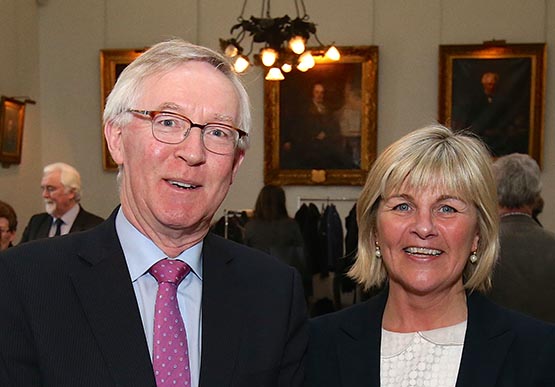
Dragons Den star Bobby Kerr – a sailing man himself – was the lively Master of Ceremonies
But in terms of being a setting which lends itself very positively to such a gathering, College Hall is right on target. It’s a splendid room which is confident with itself without being over the top. It comfortably accommodates the crowd of between 180 and 200 who have come from all over Ireland to celebrate what’s best in our sailing. And as if that weren’t enough, the RCSI has remarkable links with sailing going back more than a hundred years.
John Treacy, CEO of the Sports Council, with Liam Shanahan and ISA President David Lovegrove
So after last year’s first use of the venue, which stemmed from a typically far-sighted suggestion by ISA Board Member Brian Craig, people were keen to go back. And it wasn’t because no-one could think of anywhere better. On the contrary, it was because we’d found that the College of Surgeons is one of those wonderful buildings which make you feel better just from being in it. So in the early days of Spring when we wonder if summer is really going to come at all, a bit of a party in the College of Surgeons is just what the doctor ordered. And as for those doctors and surgeons from the RCSI going sailing, we’ll return to that at the end of this piece. But what of the event itself?
Well, with the Afloat.ie Sailor of the Year award going to a determinedly Corinthian skipper who cheerfully admitted that there’s any amount of professional sailors out there who could probably beat the pants off him, but nevertheless his core interest is offshore racing with family and friends, and if they win within those self-imposed limitations, then so much the better…..There it was, the real voice of Irish sailing, and no mistake.
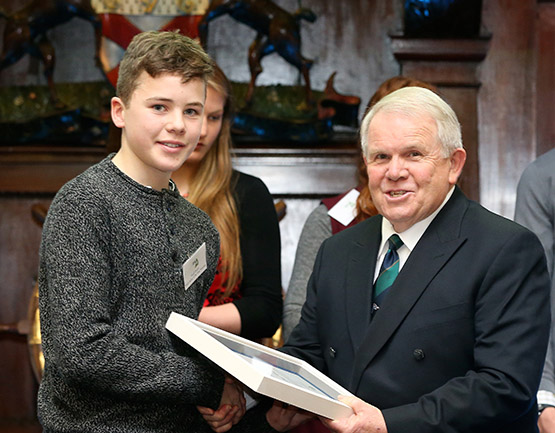
Pierce Purcell of Galway Bay SC with the RIYC’s Michael Boyd, Commodore of the Royal Ocean Racing Club
But what about the clubs through which we go sailing? How can they carry such a wealth of history, and yet be of any contemporary relevance? Here again, the evidence speaks for itself. The new Mitsubishi Motors Sailing Club of the Year has a wonderful history going back to 1831, yet in terms of sailing achievement and voluntary input into the local, regional and national organisation of sailing, it is making a fantastic contribution. And as for its relevance to sailing in the future, independently of the Club of the Year adjudication taking place, this same club was comfortably on its way to being the top ISA Training Establishment in its region, and on the shortlist for the national title too.
Olympian and rising stars – James Espey, Aoife Hopkins and Saskia Tidey
If that’s not an illustration of the way that Irish sailing honours its past while living in the present and looking to the future, then I don’t know what it is. But what’s this third point about Ireland being a cold place for professional sailing? Here again, the assembly in the RCSI was very representative of our Irish sailing population. For sure, there are some very distinguished Irish professional sailors, and there are certainly Irish owners who are prepared to pay the top talents to sail with them. But there’s something about the Irish sailing scene which is inimical to such a setup at home. By all means do it where the weather’s usually benign, and there’s lots of money floating around. But in the Irish climate you sometimes have to be so keen to go sailing despite hostile weather that you just have to rely on nutty amateur crew - the professionals know there’s much better and more reliable pickings elsewhere.
Thus we’ve come to the ironic situation that our top home-based professional sailors are actually our Olympic hopefuls. It’s extraordinary when you think that the modern Olympics were “re-founded” in 1896 in order to celebrate amateur sport, yet now in Ireland just about the only home-based sailors who can be said to be professional are the Olympic aspirants. And if they haven’t accepted that they need a professional approach, then they’re not really at the races at all.
Thus although the friendly Olympian presence of Annalise Murphy, James Espey and Saskia Tidey was much to be welcomed in the very representative throng, generally anyone who was there with any sort of a professional interest in sailing had it as part of a larger business in which actually going sailing is only a small part of the total setup.
Paralympic sailors Ian Costello and John Twomey
Admittedly we did have one Olympian who received an award, John Twomey who took the title in December for his qualification for the Paralympics in September 2016. And he came with added laurels, as on the very day of the ceremony, it had been announced that he and his crew of Ian Costello and Austin O’Carroll had moved up to fifth in the World Rankings. But if you suggested to John Twomey – headed for his 11th Olympiad – that he’s a professional sailor, he’d be convulsed in mirth. Real life is related to an accountancy practice in Kinsale.
So the only other monthly awardee who could remotely be said to be a professional sailor was August winner Ronan O Siochru. who skippered the winning Irish Offshore Sailing boat Desert Star to victory in the 33-strong Sailing Schools Division in the Rolex Fastnet Race 2015. But he’s very definitely running a business - and a very demanding one at that – in which going sailing is only part of it.
Ronan O Siochru with the President
Thus what Thursday’s ceremony was all about was voluntarism and amateur sport, and in case anybody missed the point, it was supposed to be a bit of fun. In this spirit, the greatest trophy in Irish sailing, the might salver for the Helmsman’s Championship, was given an outing. The All Ireland Helmsman’s Championship being an amateurs-only affair, as it is held over an October weekend, inevitably by the time its award ceremony for the salver is shaping up it’s well into Sunday evening. It’s getting dark, and everyone’s tired and wants to go home. So inevitably the handing-over of the historic trophy is a downbeat and somewhat rushed affair.
But as the ISA Annual Awards ceremony is all about handing over prizes with as much ceremony as possible, it was arranged for the salver – which had been hurriedly handed over to successful defender Anthony O’Leary in Dun Laoghaire back in October – to be smuggled out of the O’Leary household down in Crosshaven, secretly taken to Dublin, hidden away in the College of Surgeons, and then formally presented as a surprise extra to the great man after he’d received his Sailor of the Month award for April. He blushed.
Got him! Sailor of the Year 2014 Anthony O’Leary unavoidably missed last year’s awards ceremony, and then in 2015, although though he was Sailor of the Month for April, there were very few people around in October when he successfully defended the Helmsmans Championship Salver. So it was taken secretly to this week’s ceremony, where more than 180 people cheered him to the rafters.
ISA Youth Champions 2015 are Colin O’Sullivan and Doug Elmes, Bronze Medallists in the 420 Worlds.
Before all this, we’d been setting the scene with the ISA Youth Sailors of the Year, who were 420 Worlds Bronze Medallists Douglas Elmes and Colin O’Sullivan, and the ISA Training Centre of the Year, which was Mullingar Sailing Club from Westmeath which headed the Western Region, and overall came in ahead of Foynes YC from the Southern Region and the Royal Irish YC from the Eastern Region.
Katie Johnston of Mullingar Sailing Club with David Lovegrove when MSC was announced as ISA Training Centre 2015.
The new Mitsubishi Motors Sailing Club of the Year is the Royal Irish YC – Commodore James Horan with Billy Riordan of Mitsubishi Motors and David Lovegrove.
But for the RIYC Commodore James Horan, the good news was only beginning, as his club was then announced as the new Mitsubishi Motors Sailing Club of the Year for a host of excellent reasons. We’ll list them in more detail here on Afloat.ie in due course when the traditional handing-over ceremony for the old ship’s wheel trophy is held in the RIYC clubhouse later in the Spring. But meanwhile on Thursday we saw ample reason for it, as two of the Sailor of the Month awards went to very active RIYC members, George Sisk and Tim Goodbody.
July Sailor of the Month George Sisk with the ISA President
Dun Laoghaire Regatta Week 2015 Chairman, Fastnet Race 1987 overall winner, and multiple champion Tim Goodbody was Sailor of the Month in November
Youngest cruising award winner was Fergus Ogden, who in June and July sailed round Ireland with his brother in an open Drascombe Lugger.
Then came the Sailor of the Year announcement. Anyone who was following the voting in the Afloat.ie poll will know it was running very close. But as the poll results are only a quarter of the adjudication process, it was just a couple of days ahead of the awards ceremony when the judges finally made their decision. They came down in favour of Liam Shanahan both for his wonderful and very sporting victory in the Dun Laoghaire to Dingle Race with his family’s J/109 Ruth, and his subsequent success in retaining the Irish Sea Annual Championship title.
His modest acceptance speech was, in effect, a manifesto on behalf of all Irish amateur sailors, and particularly family sailors. The Shanahans are one remarkable sailing tribe right through three generations. And as for that win in the Dun Laoghaire to Dingle Race – well, it was beautiful sailing. Some sailing races are won by brutal slugging. Some are won by sheer cunning. Some inshore races are even won by dirty sailing, and it’s within the rules even if it does the image of our sport no good at all. But some race wins are simply beautiful sailing. And Ruth’s success in Dingle was definitely in that category.
After receiving his award, Liam Shanahan briefly but eloquently outlines his philosophy of sailing
So the ceremony on Thursday concluded with this celebration of the best in Irish sailing, and it chimed well with the mood of the moment and the location, as the current President of the RCSI is Declan Magee who sails from Dun Laoghaire, and he was most welcome at the party and naturally thanked for the use of the hall……
Then as we exited the College Hall, the first doorway we passed was the Sir Thomas Myles Room. He was RCSI President 1900-1902, a wonderful surgeon and a man of prodigious energy who boxed to championship level, and adored sailing. A Home Ruler of Limerick origins. he made his auxiliary ketch Chotah available to take the guns off Conor O’Brien’s Kelpie during the Asgard gun-running of 1914, and landed them in Kilcoole in County Wicklow. And though he was immediately made a Colonel and head of British army surgical services in Ireland on the outbreak of the Great War of 1914-18, he also saw to it that hidden rooms in the major Dublin hospitals under his control were available to treat wounded rebels, indeed anyone who was wounded, during the Rising of 1916.
Builders of the future – the team from Mullingar Sailing Club, ISA Training centre 2015
More recently, a leading sailing figure with links to sailing is Michael O’Rahilly who, when he became a student at RCSI at the end of the 2950s, found that the RCSI Sailing Club consisted of just one neglected Firefly dinghy. By the time he graduated in 1963, he was Club Captain, RCSISC had three Fireflies in top racing condition, and they were the Irish university champions.
Subsequently he went in to play a leading role in Dublin Bay SC, and was the Commodore for the DBSC Centenary in 1984. He follows in a notable RCSI tradition of sailing and working voluntarily for our sport, as an earlier top sailor in the college had been Jimmy Mooney who played a key role in the development of Irish dinghy sailing, and then went on to be our top Dragon sailor for many years, winning the Edinburgh Cup and representing Ireland in the Olympics.
Before Jimmy Mooney another noted character in the RCSI sailing scene was Rory O’Hanlon, who became a noted figure in offshore racing – he won a cup in the 1971 Fastnet Race – and was further renowned for his long distance cruising exploits.
He was noted as a kindly mentor to young cruising hopefuls, gently giving encouragement which could make all the difference to a nervous skipper. One such beginner, who later went on to great achievements, nervously went to Rory O’Hanlon to ask how best he should approach his first major voyage, north towards the Arctic in a little 26-footer.
“Sure, you just keep on sailing, and you’ll get there” said Rory. “Just keep on sailing, that’s all there is to it”. Just keep on sailing. It’s sensible advice. It resonated round College Hall in the RCSI on Thursday afternoon. We should all heed it.
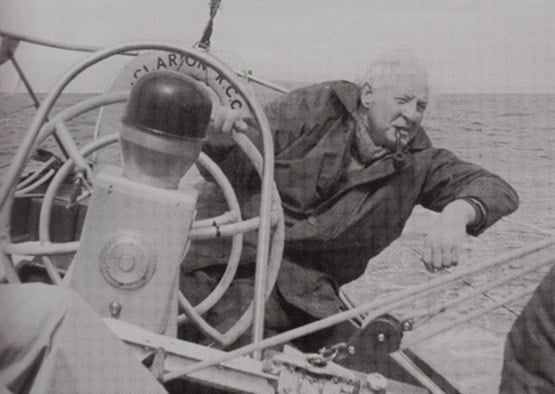
“Just keep on sailing, and you’ll get there”. The late Rory O’Hanlon at the helm of his S & S 43 Clarion with which he won the Philip Whitehead Cup in the 1971 Fastnet Race, and also cruised on long voyages. While a student at the Royal College of Surgeons in Ireland, he was active in the sailing club.
See also: Sailing Awards slideshow
A New Direction for the Irish Sailing Association in 2016
ISA President, David Lovegrove on the year past, and his plans for 2016
2015 began with huge momentum for change in the ISA. The re-evaluation of the organisation's strategic vision, which was led by Neil Murphy, culminated in an extensive national consultative process which was finalised with the approval of the ISA Strategic Plan 2015-2020 at the AGM in March. The ISA now has a blueprint to guide the organisation through the acknowledged serious challenges confronting sailing and boating in Ireland.
2015 saw a number of stalwart and energetic Board members resign at the end of their term; Mike O’Connor, Muriel Rumball and Phillip Cowman. It is important to record our appreciation of the immensely effective effort all these directors made over several years. We have been fortunate to attract new blood of the same high calibre such as Robert Dix, Paddy McGlade and Sarah Byrne. Each brings a wealth of unique specialist experience.
The year started with our inaugural annual awards scheme, jointly held with Afloat, when unsurprisingly, Anthony O'Leary won the Sailor of the Year Award, and Royal Cork Yacht Club deservedly took the 2014 Mitsubishi sponsored accolade for Club of the Year. Youth Sailor of the Year was earned by the National Yacht Club’s Finn Lynch who had a stunningly successful season and finally, Mayo Sailing Club took the Training Centre of the Year award.
Early summer saw the launch of Try Sailing, an initiative devised by Board Directors Muriel Rumball and Pierce Purcell. The plan was to attract at least 3,000 newbies to get out on the water in Clubs and Training Centres all around the country. It was an outstanding success and there are high expectations of the plans to significantly extend the reach of Try Sailing in 2016.
2015, aided by great breezes, witnessed many successful National and International events in Ireland, including the ICRA Nationals, superbly hosted in Kinsale; the Volvo Dun Laoghaire Regatta, with over 400 boats on the water and 1,000s ashore enjoying the atmosphere and the craic. Dinghyfest, was, as always, expertly managed by the Royal Cork Yacht Club in mid-August. On the international front, there were some outstanding achievements, such as Shane McCarthy and Andy Thompson winning the highly competitive British GP14 championships in July and in the Fastnet in August, which proved once again, that Ireland can punch above its weight internationally with a number of great results in very difficult conditions.
At the risk of inadvertently omitting other worthy racing achievements, it would be remiss not to mention Justin Slattery’s win on Abu Dhabi in the Volvo round the world race and Dave Cullen’s great result in winning the Half Ton Classic Cup with Checkmate XV.
We cannot look forward to 2016 without mentioning our Olympic Athletes who are all presently travelling the world to participate in the toughest competitions to prepare for Rio 2016. We wish them well and confidently expect them to fly the Irish Flag in Rio with pride and hopefully some success.
2015 was a year when a lot of back–room energy was expended on preparing fresh initiatives which are planned to reinvigorate sailing activity, particularly amongst young adults. Presently, a consultative process will shortly be underway to brief all clubs and training centres on these changes. In 2016, Brian Craig hopes to announce the establishment of a National Coaching Programme which will be accessible to every sailor of whatever skill level or interest.
Changes to the small boat sailing scheme have been made to encourage a lifelong love of the sport with less emphasis on the acquisition of “certificates”.
The ISA continues to lobby Government on a range of issues, such as the urgent need for a replacement to the Small Craft Register, rationalisation of the system for granting foreshore licenses, etc. The list is endless!
I trust you are already making your sailing plans for next year and I wish you all safe and enjoyable times on the water in 2016.
David Lovegrove
A Great Season of Sailing & Renewed Energy on the Water
ISA President David Lovegrove on the summer past and the close of the 2015 season.
Despite the poor summer weather, record numbers of sailors took to the water across the country, especially in regattas. I was delighted to see Irish racing success abroad, with ISA performance sailors placing higher in greater than ever numbers internationally, and team achievements, such as the British GP14 championships in July and the Fastnet in August.
A notable success on the National front was DinghyFest, which was expertly hosted by Royal Cork Yacht Club (RCYC) in mid-August. I was delighted to see this much-demanded event showcase Ireland’s talented dinghy sailors. The ISA intends to work with the organisers to build on its success in the future; and I particularly welcome this evolution on the national dinghy front as it fits with the ISA’s strategic plan of growing this area within Irish sailing.
On the club front; the ISA made a submission to An Bord Pleanála regarding the Dun Laoghaire Harbour Company's proposed plans to bring international cruise ships to the harbour. We are working closely with the combined clubs in Dun Laoghaire on this issue - protecting this historic amenity for future generations is a priority for the ISA.
I am also pleased to bring you news of a partial rates relief for Community Sports Clubs, which the Irish Federation of Sport was influential in securing recently. This benefit is intended to provide clubs, including all ISA affiliates in Ireland with much needed added financial security in these times of fiscal insecurity.
Local engagement at the core of what we do at the ISA; and we are taking the lead in this over the coming months. The ISA Directors and I will meet with clubs and centres around the country to discuss issues that affect them and where the ISA can be more engaged.
Spring 2015 saw Try Sailing kick-off with Minister Coveney and to date has proven successful, with over 50 clubs and centres taking up the initiative and many more set to join in 2016. We are currently developing all of the tools to take this programme further and expand its reach across the nation – stay tuned to sailing.ie for more on this.
I would like to take this opportunity to welcome new Board member Sarah Byrne of Greystones Sailing Club. As a former Club Commodore, Sarah joins the Board with a wealth of sailing club and class association experience, and I very much look forward to working with her. Sarah replaces Muriel Rumball who recently stepped down. I would like to thank Muriel for her service and in particular for her work on the Access and Participation policy group.
Two events I particularly look forward to every year are the ISA All Ireland Junior and Senior Championships. Kinsale Yacht Club were the excellent hosts for the Junior Championships in late September and saw Peter McCann of Royal Cork secure the crown, with Clare Gorman taking the girls' title. The National Yacht Club hosted the senior All Irelands (Helmsman Trophy) in early October. Ireland’s top sailors from a variety of classes went head–to–head in J80s and raced for the title over two days. Defending champion Anthony O’Leary retained his crown in emphatic style, dominating proceedings over the weekend, with Monkstown Bay & Royal Cork sailor Alex Barry taking a hard-fought runners-up spot.
Finally; two ISA Performance teams are still hoping to qualify the nation for next year’s Olympic Games. Andrea Brewster and Saskia Tidey in the 49er FX class will attempt to qualify at their World Championships in Argentina in November. Ireland’s Paralympic Sonar team will also attempt to qualify for the Rio 2016 Games at the IFDS Combined World Championships in November in Melbourne. Best of luck to both teams.
Yours in Sailing
David Lovegrove
2015 Will be 'Pivotal Year' for Irish Sailing Association
#sailing.ie – Irish Sailing Association (ISA) President David Lovegrove gives an update on a fundamental restructure of the organisation
Following the AGM in March 2014, the Board of the ISA received the report of the Strategic Review Group chaired by Brian Craig. In response to its extensive recommendations, the Board initiated a fundamental restructure to re-establish the organisation's relevance to its membership and focus its energies and capabilities on core activities.
Organisational and governance changes have been adopted together with a rationalisation of the professional team, a significant reduction in overheads and the disposal of surplus assets.
These changes allow resources to be re–allocated more directly into providing support at regional and club level and also reflect a change in emphasis from that of largely performing a regulatory role to one of being a source of active guidance at grass roots. This will be achieved within a cost structure which is realistically matched to the existing income profile.
In consultation with the Board and the recently formed Policy Groups, which are a valued source of expert advice on key areas of policy and activities, the Strategic Planning Group under the Chairmanship of Neil Murphy, is developing a new 5 year Strategic Plan 2015-2020. Following consultation with clubs and affiliated organisations in the New Year, this will be presented for consideration and approval at the next AGM in March 2015.
In the meantime, major changes to communications and PR are being implemented with a new website to be launched early in 2015, a collaboration agreement being signed with Afloat Magazine and a newly formatted high profile event, details for which will be announced shortly, that will pay tribute to our sailing achievers at both international and national level.
The training area will see innovative initiatives in 2015 with the launch of an online logbook for the Small Boat Sailing Scheme, the publication of a Junior Organisers' Handbook and the appointment of National Trainers for Sailing, Windsurfing and Power Boating. A Pathway for clubs looking to develop more double –handed sailing at local level for juniors will be finalised in 2015.
The ISA will also focus on developing a structured approach designed to make Coaching resources more readily accessible to sailors of all abilities and interests, including keelboat sailors, and ensure a trickle down benefit from the outstandingly successful High Performance programme.
With a revised and extended structure of Regional/Sailing Development officers, the ISA foresees working much more closely with Clubs, Class Associations and the Irish Cruiser Racing Association to coordinate plans for increased participation levels and sharing of resources. As part of this, it is planned to develop a comprehensive database on racing activities both at Club and at National level. Addressing this lack of information is regarded as key to the development of strategies to enhance and grow racing activity levels.
Cruising represents a large constituency of regular sailors and in consultation with The Irish Cruising Club and other established cruising groups, it is proposed to become more supportive in serving these interests by assisting in organising cruising symposiums, promoting Cruise –in–Company initiatives and providing reliable information on berthing facilities and visitor moorings around the country.
Increasing participation in sailing has long been a strategic objective of the ISA and if club membership and participation levels at many sailing events are an accurate indication of activity, it is clear that a major challenge to be confronted exists in making the sport more accessible and attractive to new participants. We also need to ensure that those who are regularly involved in the sport, but not necessarily as members of clubs, can find cost–effective ways of becoming more formally integrated into our club infrastructure.
During this re–direction of emphasis, it remains a major priority for the ISA to continue delivering its current range of services and competently discharge its responsibilities as the National Governing Body for Sailing.
2015 will be a pivotal year in executing this new direction for the ISA and success will be heavily reliant on the contribution and interaction of all sailors, whatever their interests or needs.
Finally, a big thank you is warranted to the professional team in the ISA and to all the volunteers who have energetically and generously contributed to what has been a very challenging eight months for the ISA.
David Lovegrove,
President
Irish Sailing Review 2014: A Year Of Hope, Regeneration & Success
#irishsailingreview – 2014 has been the year in which Irish sailing regained its international confidence afloat by re-capturing the Commodore's Cup. Having won it in 2010, the national economic collapse prevented any defence in 2012, but in July 2014 the stain and shame of 2012's non-appearance was emphatically wiped from memory with a convincing team victory led by Anthony O'Leary.
Ashore meanwhile, it had taken longer in some quarters for the economic realities to become fully evident and accepted. But for the Irish Sailing Association, a grassroots revolution within the national authority and sailing in general in 2014 resulted in a root-and-branch analysis of the workings of the Association, which had been heading towards financial disaster through a combination of over-staffing, grandiose schemes of expansion and empire-building, and an emphasis on activities and programmes which were remote from the needs of ordinary sailors throughout Ireland.
It took six months to turn round the course of the Association. But on November 5th 2014 the new ISA President, David Lovegrove, was able to announce a far-reaching re-structuring which is already resulting in a leaner and fitter body, better able to provide a realistic service for clubs and the huge diversity of recreational activity on Ireland's seas and lakes.
While all this high profile activity and action has been taking place at international and national level, those Irish sailors who had managed to keep up their sport through the financial downturn – albeit in often very reduced circumstances – continued to sail their boats with the attitude that, while the economic situation was disastrous, it mustn't be allowed to become serious, and in some ways the best course out of the recession was to sail through it. W M Nixon casts an eye over the year's main activities.
In the Irish sailing year, Christmas Day is New Year's Eve. Next morning, on December 26th – St Stephen's Day or Boxing Day or whatever you're having yourself – the annual 628-mile Sydney-Hobart Race starts. It may be on the other side of the world, and it may still be in the very last days of the old year. But Irish interest at home and in Irish-Australia is always high, and in the sailing community it's seen as the start of the new season.
December 26th 2013 was in line with this, as we'd ex-Pat superstar Gordon Maguire – a previous Hobart race overall winner – very much in contention with Matt Allen's totally new Carkeek 60 Ichi Ban, we also had Sean McCarter of Lough Swilly YC skippering Derry/Londonderry in the warmly-welcomed Clipper Fleet of 70-footers designed by Tony Castro (formerly of Crosshaven) which were taking in the Hobart race as part of their global circumnavigating race, and we'd Barry Hurley and Kenny Rumball on the First 40 Breakthrough knowing that in the 2010 Hobart race, the new design's race debut, First 40s had taken first and second overall.
In a rugged race in which the wind got up to gale force and more towards the end, it was a much-loved hundred footer, Bob Oatley's continually-modified Wild Oats XI, which stole all the headlines with line honours, a course record, and a class win. Irish hopes were best met by Sean McCarter, who logged a very clear win in the Clippers. As for Ichi Ban, while she was third in IRC Div 1 and 8th overall, it wasn't quite a stellar performance, reinforcing the views of those of us who think the boat may be just a little too plump by today's lean and hungry standards. And aboard Breakthrough, they'd 8th in class and 29th overall, a useful performance perhaps, but Barry Hurley will be back on December 26th 2014, boosted by his first in class and second overall in October's Middle Sea Race.
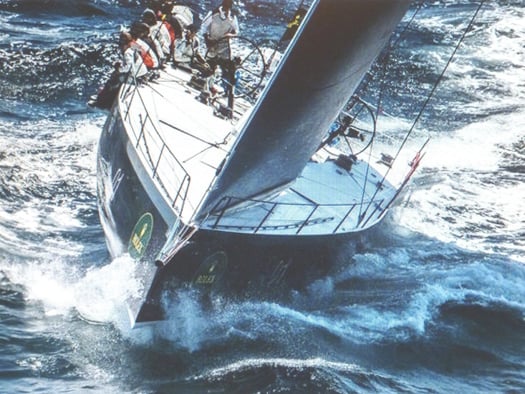
Matt Allen's Ichi Ban in the Rolex Sydney-Hobart Race of 2013, with Gordon Maguire as sailing master. To some observers, the very new Carkeek 60 seemed distinctly plump in her hull form forward compared to her closest competitors
In late January 2014, attention focused on the Quantum Key West Regatta in the Florida Keys, where Irish Olympic sailor Peter O'Leary of Cork was on the strength of New York art dealer Marc Glimcher's completely new and very potent looking Ker 40 Catapult. The boat did the business afloat in Florida, but further business was done ashore, as Anthony O'Leary himself was in Key West to see if he could sign up Catapult to be the secret ingredient in Ireland's Commodore's Cup team, for which at that stage the only certainty was his own older Ker 39 Antix. There seemed to be agreement, but in the volatile world of international trading and snap decisions in which top modern sailing operates, there can be sudden reversals of fortune, and O'Leary later admitted that until Catapult was actually unloaded from a ship in Europe, he hadn't been a hundred per cent certain she'd show.
Key West had further Irish interest in that veteran skipper Piet Vroon's Ker 46 Tonnere de Breskens – a former Round Ireland Race winner – was another star in the show, but much was to happen in Irish sailing before the Round Ireland 2014 got under way in Wicklow on June 28th.
With March slowly showing signs of Spring, university racing came centre stage, and it was University College Dublin which came through on top to qualify as Ireland's representatives in the Student Yachting Worlds in France in October, the team led by Philip Doran.
Another team was emerging as the Irish Cruiser Racing Association (ICRA) announced that our Commodore's Cup squad would be Anthony O'Leary's Ker 39 Antix, Marc Glimcher's Catapult, and the Grand Soleil 43 Quokka chartered by Michael Boyd and Niall Dowling, with Anthony O'Leary as team captain. He in turn would be supported by the shore management team, for a very intense week of racing, of Barry Rose and Fintan Cairns, with Mike Broughton in what would prove to be the particularly onerous task of Team Meteorologist.
As 2014 was exactly midway between two Olympiads, top level international dinghy sailing to Olympic standards might have been expected to be on the back burner. But Ireland's Olympians were very much on track on the international scene, and busy with their own programmes which culminated in the ISAF Worlds in Santander where Olympic places in Rio de Janeiro for 2016 were secured by James Espey in the Laser, Ryan Seaton & Matt McGovern in the 49er, and Annalise Murphy in the Women's Laser Radial. All were of course also seen in other boat types from time to time, with Annalise in particular bringing some glamour to the growing class of foiling Moths in Ireland.
Annalise on the foiling Moth
Other top international women sailors had descended on Ireland in early June with the ISAF Women's Match Race Worlds at Crosshaven. It's very much a specialist sailing interest, but aspiring Irish woman sailors attracted to this discipline found that this successful regatta provided some very useful networking contacts and future crewing possibilities, while the racing itself saw Sweden's Anna Kjellberg of the Royal Gothenburg YC become the new champion after defeating Camilla Ulrikkeholm of Denmark in the final.
In an entirely different area of sailing and life afloat, the traditional boat scene had come early to life with the Baltimore Wooden Boat Festival at the end of May. In the Irish climate after a particularly damp Spring, it reflected great credit on those involved that there was such a good turnout, ranging from the Shannon Gandelows from Limerick recently returned from their historic visit to Venice, through the many restored classic yachts of the region, also including the lovely Shannon cutter Sally O'Keeffe from Kilrush, and going on into the restored traditional mackerel and lobster yawls which make West Cork their home.

Shortly after their historic visit to Venice, the Shannon gandelows built by the Ilen School took part in the Baltimore Wooden Boat Festival at the end of May. The gandelow here, rowed by Liam O'Donghue, Anthony Kenny and Robert Samlle, is headed across Baltimore Harbour towards the gaff ketch Sile a Do.
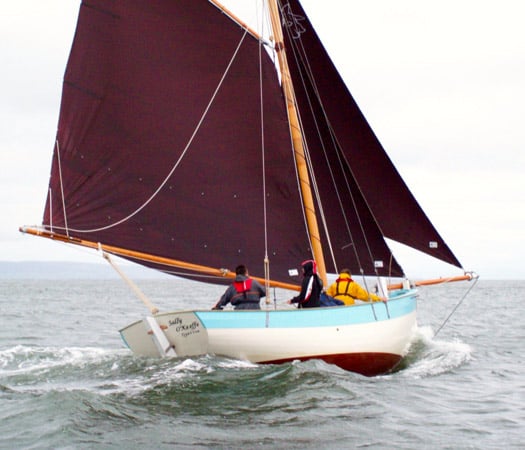
The pride of the Shannon Estuary - Sally O'Keeffe was built in a community effort in Querrin on the Loop Head peninsula.

The traditional lobster boat Saoirse Muireann (left, Cormac Levis) and the mackerel yawl An tiscaire (Uilliam O'Lorcain) are a familiar sight in the waters of West Cork. Photo: Brian Marten
They were to re-appear in even greater numbers at the Ballydehob Gathering of the Boats in early August, a month during which the classic Galway Hookers of the West Coast were at their busiest on their home Atlantic waters, but the East Coast also had its moments with the Riverfest in Dublin's Liffey in early June seeing traditional and classic craft in a lively mix.

Sails in the City – two of the 1898 Howth Seventeens racing in the heart of Dublin in the Liffey Riverfest. Photo: W M Nixon
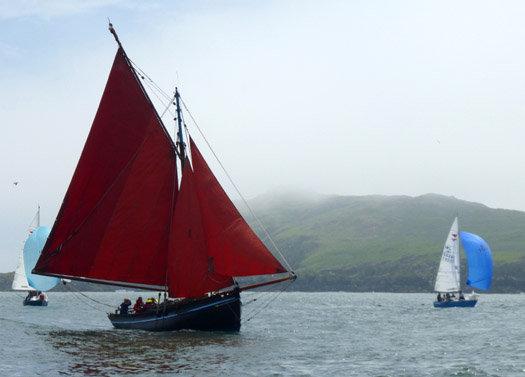
It could almost be Connemara, were it not for the Puppeteer 22s – the Galway Hooker Naomh Cronan in the new Classics & Traditional Division in Howth's annual Lambay Race, which was marking its 110th anniversary in 2014. Photo: W M Nixon
Indeed, so strong is the growing interest in classics and trads on the East Coast that to celebrate the centenary of the Lynch family's Howth 17 Echo (one of the newest of the class, the most senior ones were built in 1898) Howth YC provided a traditional Lambay Race course – simply up around Lambay and back to Howth Harbour – for the Seventeens and a new Classics Division, with the Howth 17s seeing the first two places taken by 1898 boats – Rita (John Curley & Marcus Lynch) and Aura (Ian Malcolm) – while Old Gaffers Association International president Sean Walsh won the classics with his Heard 28 Tir na nOg from the Clondalkin team's Galway Hooker Naomh Cronan. As for the overall prize among the large fleet of more modern boats sailing their more complex course, that was won by Colm Bermingham's Bite the Bullet.
The countdown to the Commodore's Cup had continued with inspirational performances by Anthony O'Leary in the Easter Challenge in the Solent, where he won his class with Antix, and then in June he did the same again with the British IRC Championship. Back home, ICRA held their Nationals with the Royal Irish YC in Dun Laoghaire in mid-June, and out of a fleet of a hundred plus boats it was the vintage Marcus Hutchinson/Rob Humphreys designed Quarter Tonner Quest (Jonathan Skerritt, RIYC) which was best overall scorer, a notably impressive performance also being put in by the Ker 36 Jump Juice (Denise Phelan) from Crosshaven.

The 27-year-old Quarter Tonner Quest (Jonathan Skerritt) was overall winner in the ICRA Nats at the RIYC in Dun Laoghaire. Photo: David O'Brien

Downhill battle at the ICRA Nats with the Mills 36 Raptor (ex-Aztec) in foreground, while beyond is Peter Dunlop of Pwllheli's J/109 Mojito against the XP33 Bon Exemple (Colin Byrne, RIYC). Photo: Davd O'Brien

The Ker 36 Jump Juice (Denise Phelan) dominated Class 0 at the ICRA Nats. Photo: David O'Brien
The end of June, and it was Round Ireland time. Thirty-six boats started from Wicklow, 33 finished in a race which was mostly on the slow side, with mid-size boats having their day. The winner was Richard Harris's Sydney 36 Tanit from Scotland by just six minutes from the home favourite, Liam Shanahan's J/109 Ruth from the NYC in Dun Laoghaire. The French defending champion, Laurent Gouy's Ker 39 Inis Mor which sails in Ireland under the burgee of Clifden Boat Club, placed third while Frank Doyle of Cork, second generation round Ireland aristocracy as son of Denis of Moonduster fame, was fourth with his A35 Endgame.
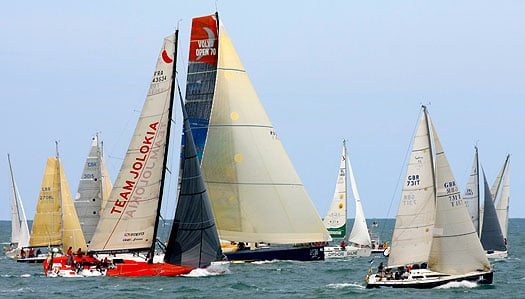
The start of the Round Ireland Race 2014 well illustrates the eclectic nature of the fleet. In right foreground is Richard Harris's Sydney 36 Tanit which was overall winner by just six minutes from the J/109 Ruth (Liam Shanahan), just beyond with the black jib, while the Volvo 70 Monster Project (David Ryan) comes thundering through the fleet at the beginning of a performance whch would see her take line honours win and thd class win in the CK Div.. Photo: Kevin Tracey
The same weekend as the Round Ireland race started, Lough Foyle sent the Clipper Fleet on their way after a week's festivities in Derry/Londonderry, made even more festive by the fact that Sean McCarter and his crew with the home town's boat had crowned their win in the Sydney-Hobart race with victory in the Transatlantic leg to Derry.
Clipper fleet in Derry
Crosshaven fairly leaped to life with Cork Week in July, and after several hitches in various boat-shipping plans, it was notable as the first time the Irish Commodore's Cup Team 2014 were seen together, and mighty impressive they looked too, with Quokka proving best on the Cork Week leaderboard.
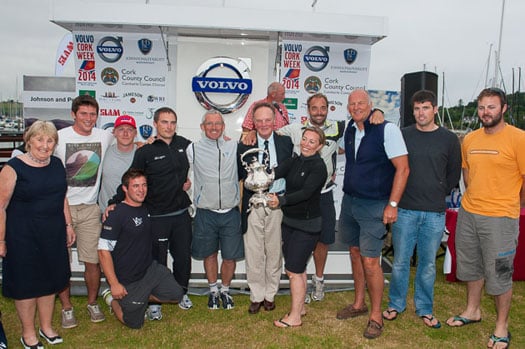
Michael Boyd (centre behind cup) and his Quokka crew, a member of Ireland's Commodore's Cup team, were overall winners of Cork week 2014. Photo: Bob Bateman
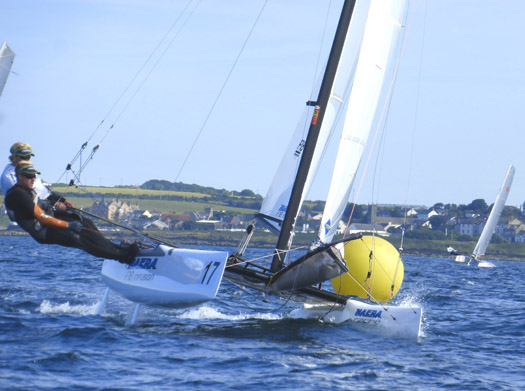
In the F18 Worlds at Ballyholme, Dutch skipper Gunnar Larssen (crewed by Ferdinand van West) is seen here putting in the smooth performance which saw him winning the worlds at his thirteenth attempt. Photo: W M Nixon
While all this excitement in racing boats with lids was building on the south coast in July, up north on Belfast Lough at Ballyholme the F18 Worlds were held for one of global sailing's most popular catamaran classes. Though the entry of 56 boats didn't match the 150-plus entries they get when the class has its worlds in its Mediterranean heartlands, the sailing was good and a popular winner emerged in longtime F18 sailor Gunnar Larsen, who is Dutch despite his Scandinavian name.
Dinghy attention was also very closely focused on Dublin Bay, with an enormous fleet of Optimists at the Europeans hosted by Royal St George YC from 12th to 20th July, and Dun Laoghaire really showing what it can do in being a major international regatta centre. France's Enzo Balanger was tops from Sweden's Kasper Nordenram, while best of the Irish in the Gold Division was Royal Cork's James McCann in tenth – not surprisingly, he was to go on to win the Nationals at his home club in August.

Nations from across Europe and beyond were at the Optimist Euros at Dun Laoghaire

Finn Lynch racing at Douarnenez in France where be became the new U19 Laser Standard world championPhoto: Trevor Millar/Sail Coach
On the broader international scene, former Opty stars Finn Lynch (National YC) and Seafra Guifoyle (Royal Cork) were to turn in outstanding results during 2014, with Guilfoyle firmly in the frame through the ISAF Youth Worlds in the Laser, eventually coming home from Tavira in Portugal with the Silver, while Finn Lynch was on top form to clinch the Gold in the Under 19 Laser Standard Worlds at Douarnenez in Brittany.
Back aboard the boats with lids, late July had brought the Commodore's Cup in the Solent, and if anyone out there doesn't know who won, we'd like to hear from them, as the state of total seclusion which this implies is surely something which could be packaged and marketed to our hyper-informed and over-crowded world. The comprehensive Irish victory just seems better and better with the passage of time, and for Anthony O'Leary it was the highlight of a fantastic season which in September was to see him win the Helmsman's Championship of Ireland (admittedly by just a whisker) in J/80s in Howth to set up a national double for Royal Cork, as young Harry Durcan of Crosshaven was winner of the Junior Helmsmans. O'Leary meanwhile went on to win the 1720 Nationals in Baltimore later that month, and then in November his beloved Antix was named RORC Yacht of the Year.

Antix in the Commodore's Cup, hanging in well coming to the weather mark to stay ahead of the newer Ker 40 Cutting Edge. Photo: Rick Tomlinson)
Even as Antix and her team mates were racing on towards glory in the Solent, in Clew Bay the West of Ireland Offshore Racing Association (WIORA) were staging their annual championship at hospitable Mayo SC, and it saw a good spread of results, with the overall winner being Galway's Liam Burke with his Corby 25 Tribal, while the runner-up was the McGibneys' Dehler Optimum 101 Dis-a-Ray, which sails under the Foynes YC burgee, but her home port is Tarbert further west along the Shannon Estuary.
August was busy with events for enjoyment. Eighty boats raced in Calves Week in West Cork, which has now been compressed to a four day regatta which means, as one sage family man observed, that you can take a house in Schull for a week's holiday, and then just as the wife and kids are getting fed up with having the ould fella always about the place, doesn't he absolutely have to go off and spend the last four days of the holiday sailing with his mates? That one of the top boats was Colman Garvey's True Penance maybe says it all.

Calves Week 2014 entries were up 25% in 2014. Photo: Bob Bateman

The GP14 Worlds at East Down YC in Strangford Lough launched a hundred boats every day in smooth style. Photo: W M Nixon
The biggest dinghy event of all (other than the Laser Nationals, which as ever are in a league of their own) was the GP 14 Worlds in mid-August at East Down YC in Strangford Lough, which had its excitement in a sudden storm on the Monday, but it all turned out okay. Boats involved were just over the hundred mark, the best boats were built in Northern Ireland by Alistair Duffin, and winners were English crew of Ian Dobson and Andy Tunnicliffe from Burwain, while top Irish were John and Donal McGuinness of Moville in Donegal, they were sixth.
At the other end of the intensity scale, down in Howth they had their first cruiser-racer two-hander for the Aqua Restaurant Challenge. Despite very restrained pre-publicity, it attracted 34 boats for a race round Lambay and the Kish. Stephen O'Flaherty's elegant Spirit 54 Soufriere, fresh from a win in the Panerai Classics in Cowes and co-sailed by David Cagney, took line honours and almost won, but the vintage Humphreys Half Tonner Harmony (Peter Freyne and Jonny Swann) just pipped them at the end.
Sailed in summery weather, the new Howth two-handed was about as different as possible from another two-handed experience in August, that of Liam Coyne (NYC) and Brin Flahive (Wicklow) in the 1800 mile RORC Seven Star Round Britain and Ireland. They didn't have to be two-handed, there were fully crew boats involved including the 70ft–trimaran Musandam in which Ireland's Damian Foxall played a leading role in taking line honours in record time, but aboard the First 36.7 Lula Belle the Irish duo just toughed it out despite sailing the last 500 miles with virtually nothing functional, they simply decided to see it through, and to their amazement found they'd won Classes V & VI.
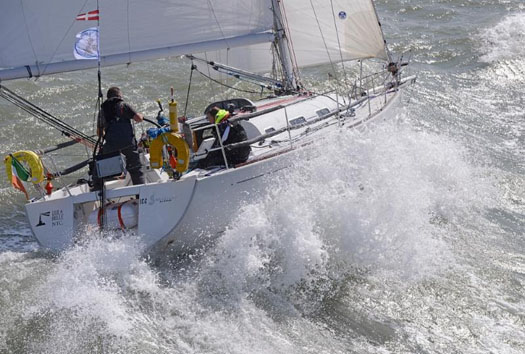
Lula Belle on her way out of the Solent with 1800 miles to race. Photo: Rick Tomlinson
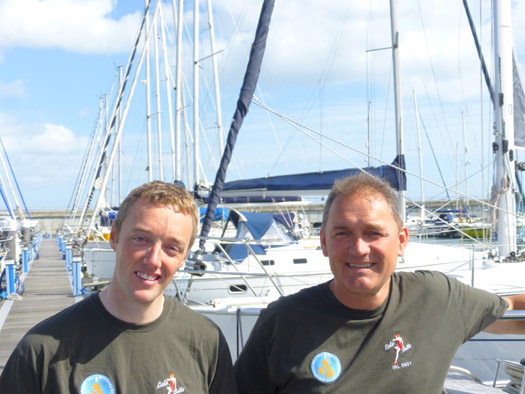
Brian Flahive & Liam Coyne back in Dun Laoghaire on the morning of their return from the finish of the Round Britain & Ireland Race. Photo: W M Nixon
As for the Laser Nats, they were at the end of August and another Ballyholme event, with Johnny Durcan of Royal Cork winning from Rory Fekkes of the home club, while the radials saw Annalise Murphy keep her hand in with a win from Cork's Cian Byrne.
After some rugged August weather, particularly on Ireland's East Coast, September was utterly blissful and it sweetly rounded out Dublin Bay Sailing Club's 130th season, the birthday being marked by a fairly epic dinner in the National YC. September also saw the conclusion of the slowly but steadily reviving Irish Sea Offshore Racing programme, with the end-of-season race from Pwllheli to Dun Laoghaire seeing Liam Shanahan's J/109 Ruth confirmed as the overall winner of the series. Among locally campaigned dinghies, meanwhile, Dun Laoghaire's keen Fireball Class kept its annual programme in lively shape, and the season drew a close with Barry McCartin and Conor Kinsella winning overall from Noel Butler and Stephen Oram.

ISORA Champion Ruth skippered by Liam Shanahan jnr from the National Yacht Club
Across country in Limerick, the CityOne dinghies and the traditional Shannon gandelows created in projects of the Ilen Boatbuilding School made their debut in the city centre on one of the last days of the Indian summer, and then they were put on display in a Naumachia in St Mary's Cathedral which was officially opened by Michael Noonan TD, and later formally visited by President Higgins.
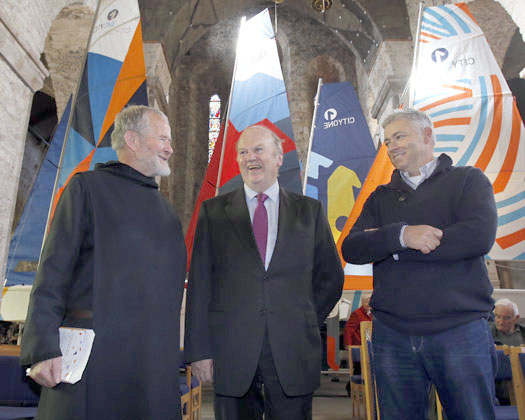
The hopeful new spirit of Irish sailing in 2014 was evident in St Mary's Cathedral in Limerick, when the CityOne dinghies built by volunteers in an inner city revitalisation project went on display in a Naumachia in the Cathedral on September 26th, after their first regatta on the Shannon in the heart of Ireland's City of Culture 2014. With the boats in the cathedral were (left) Brother Anthony Keane of Glenstal Abbey (Director, the Ilen School), Limerick's senior TD and Ireland's Minister for Finance Michael Noonan, and Gary MacMahon (right) Director of the Ilen School & Network for Wooden Boatbuilding. Photo: Press22
And then more vigorous winds returned in October, with the Freshwater Keelboat event on Lough Derg – originally just an exclusive Dragon thing – finding itself swamped with sixty and more boats from five classes and increasingly rugged conditions, such that only the Dragons and Squibs managed to get in any meaningful racing, with Neil Hegarty (RStGYC) winning the Dragons while James Matthews and Rob Jacob of Kinsale topped the Squibs.

Dragons in Autumn action on Lough Derg – Neil Hegarty (right) was overall winner from runner-up Richard Goodbody (left) Photo: Gareth Craig
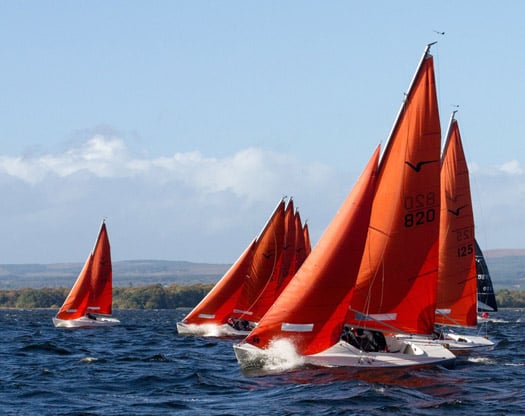
Squibs on Lough Derg – it may look like perfect sailing, but the top came off the weather very soon afterwads. Photo: Gareth Craig
The Student Yachting Worlds in La Rochelle in October had some hiccups in UCD's campaign for Ireland, but while they very narrowly missed the podium in a truly international event, they stayed put at fourth overall. And round in the Mediterranean, a record fleet for the Rolex Middle Sea Race from Malta saw entries soar through the 120 mark for the first time, and the 606 mile race had its first half in light breezes, but the second half was in pure Mistral, with people talking of "winds easing to 44 knots....." A Maltese-owned J/122 won, but second overall and first in her class was the Xp44 XpAct (Josef Schultheis) with a strong Irish emphasis in her crew including Barry Hurley, Andy Boyle, Kenny Rumball and Phillip Connor.
Soon afterwards, the Volvo World Race got under way with first stage from the Med to Cape Town, and Ireland's Justin Slattery on the winning boat on Leg 1. Back home, Autumn leagues had seen renewed enthusiasm as though people had suddenly re-discovered their sport, and the great sailing year of 2014 drew towards its close with the Lasers in Howth starting their 40th winter of annual frostbite racing. This means that HYC have now had a continuous sailing programme since April 1974, while across in Dun Laoghaire the DMYC Frostbite Series must be the most senior of all winter events. Winter Leagues attract more aficionados, with the popularity of the Dublin Bay Turkey Shoot in particular providing a forceful reminder that Dun Laoghaire is the principal sea access for a notably affluent and very large population in South Dublin. With the Turkey on its way, soon it's Christmas. And then the new Irish sailing season will begin on the blue waters of Sydney Harbour.
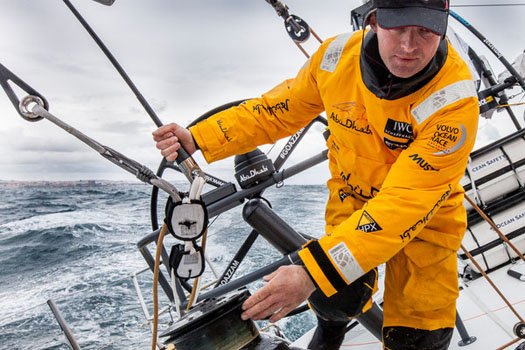
Justin Slattery on Volvo World Race 2014. Photo: Volvo Ocean Race




























